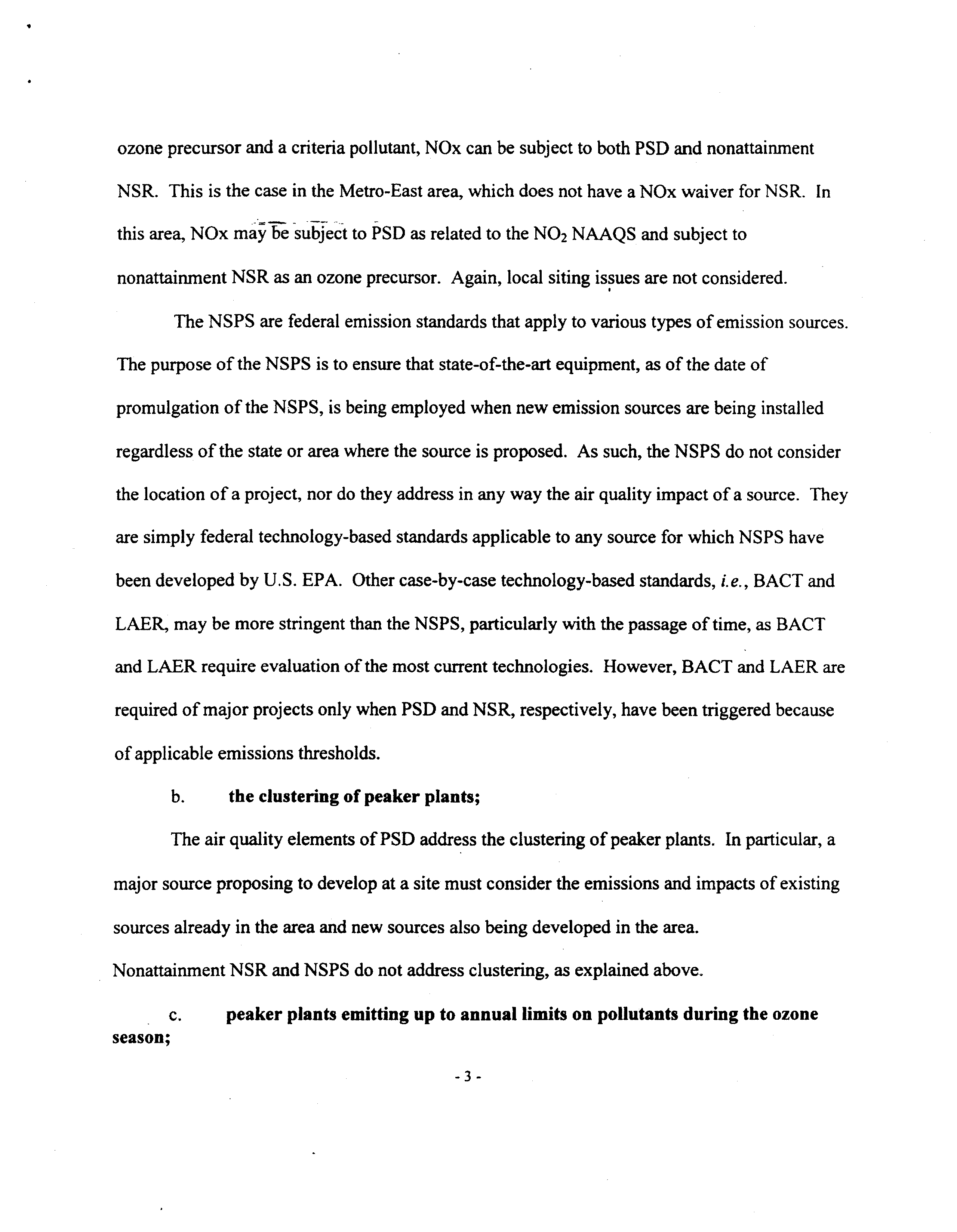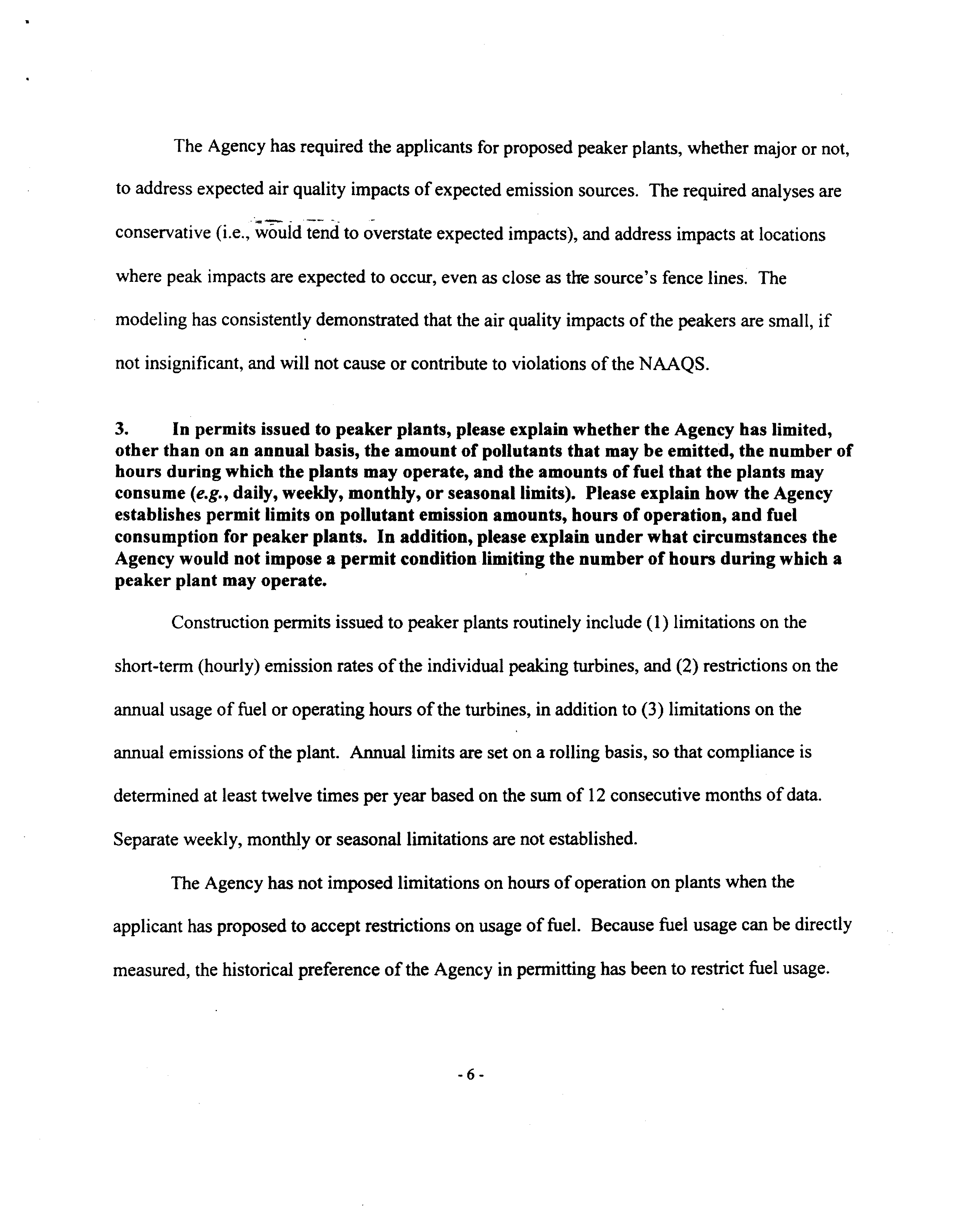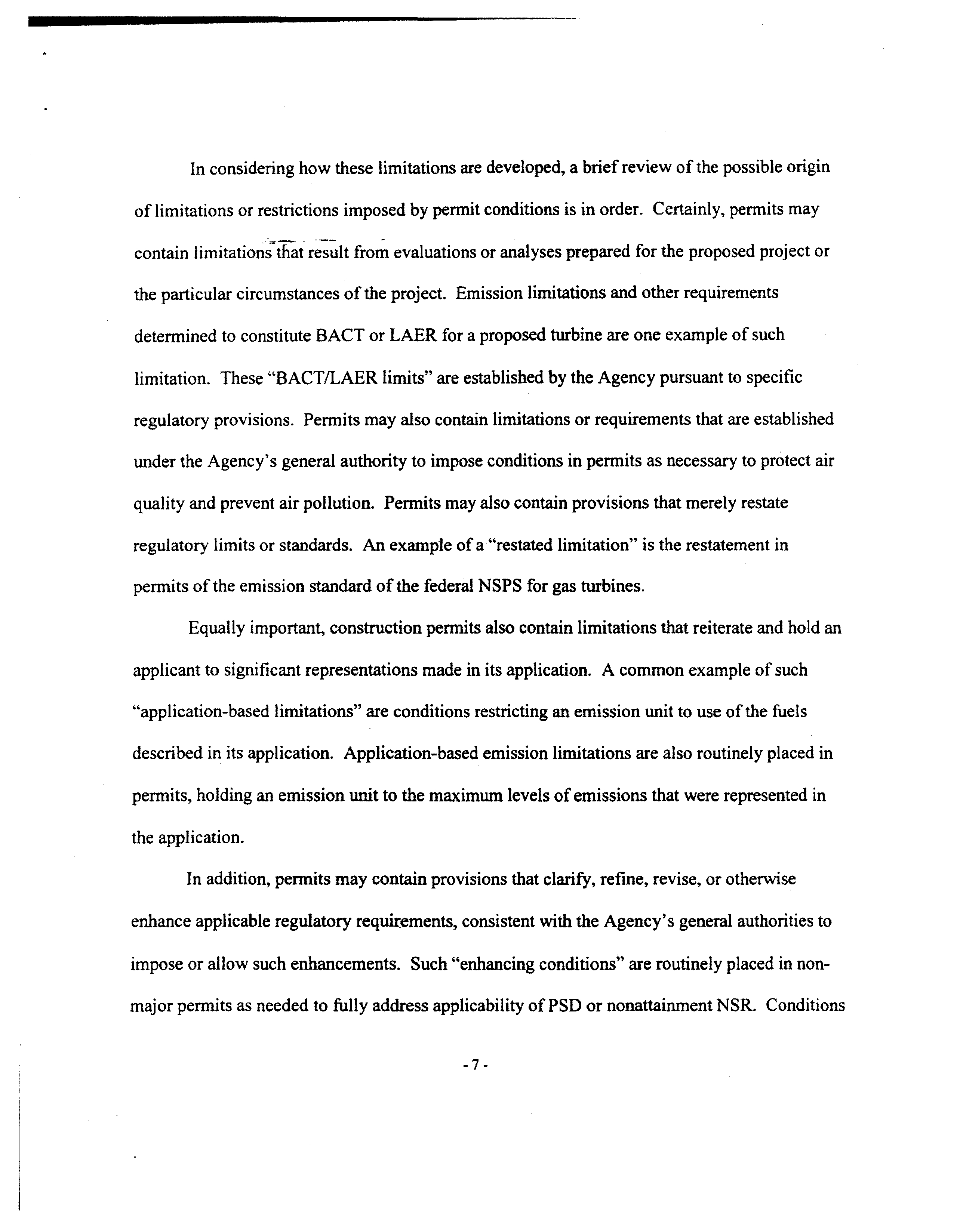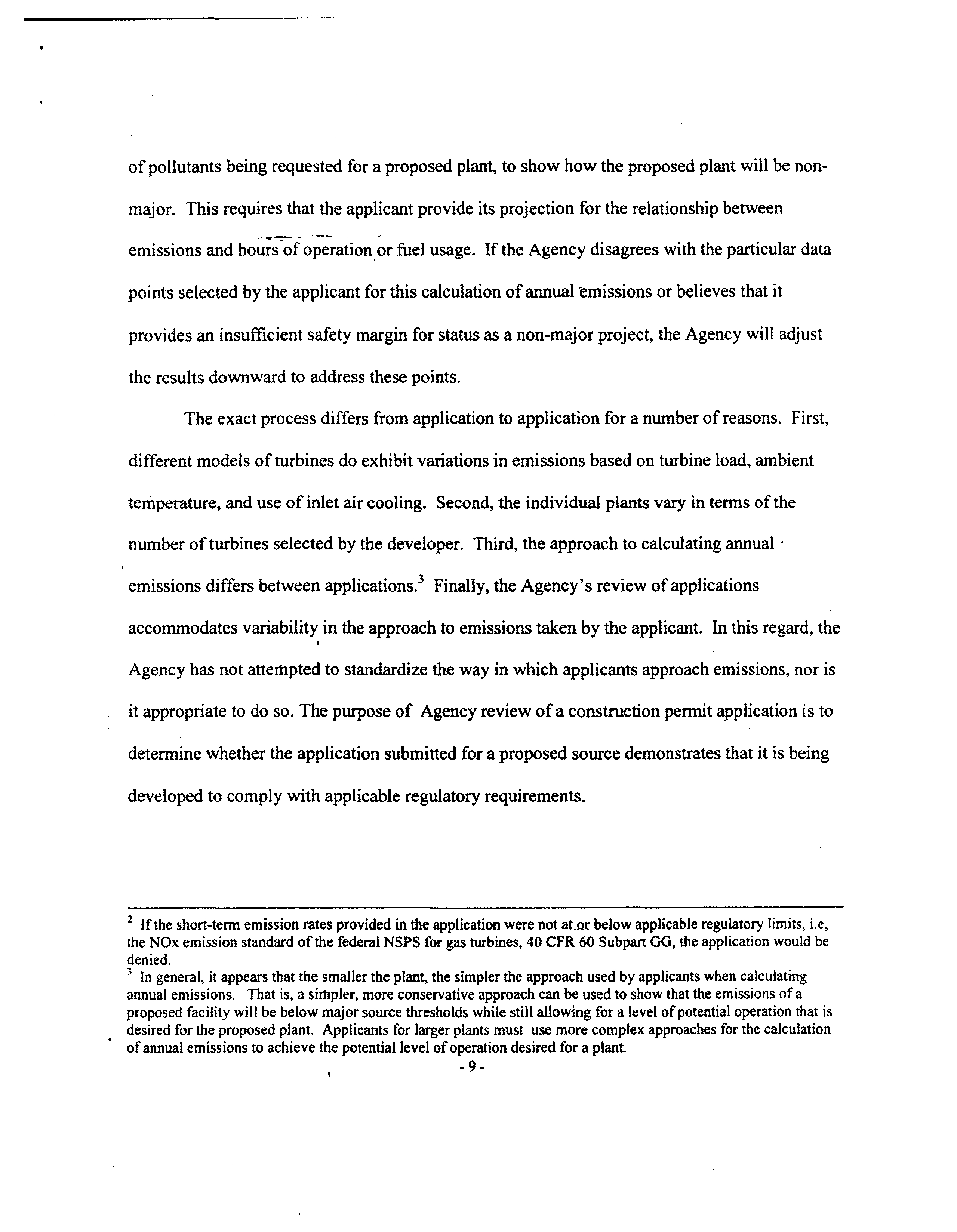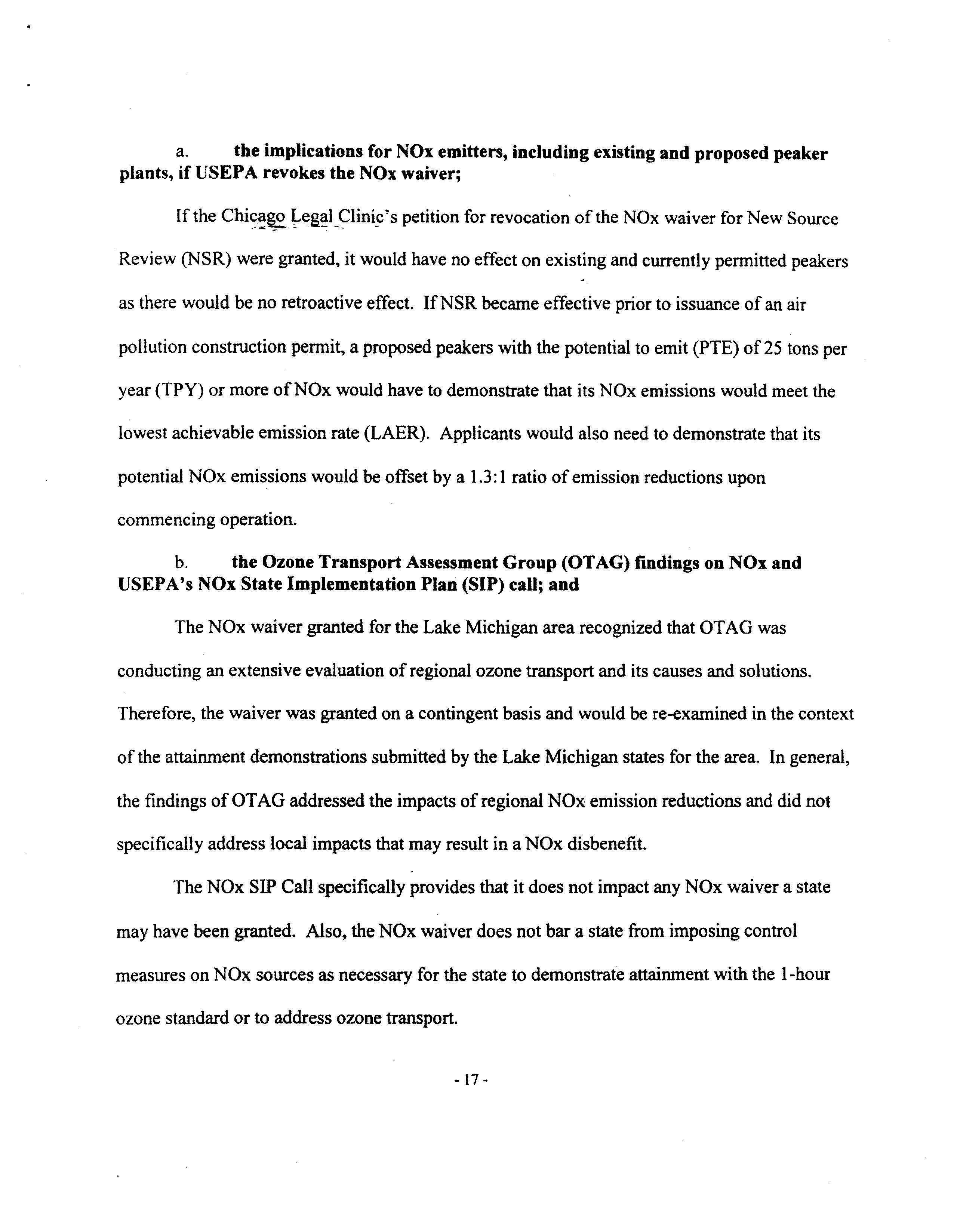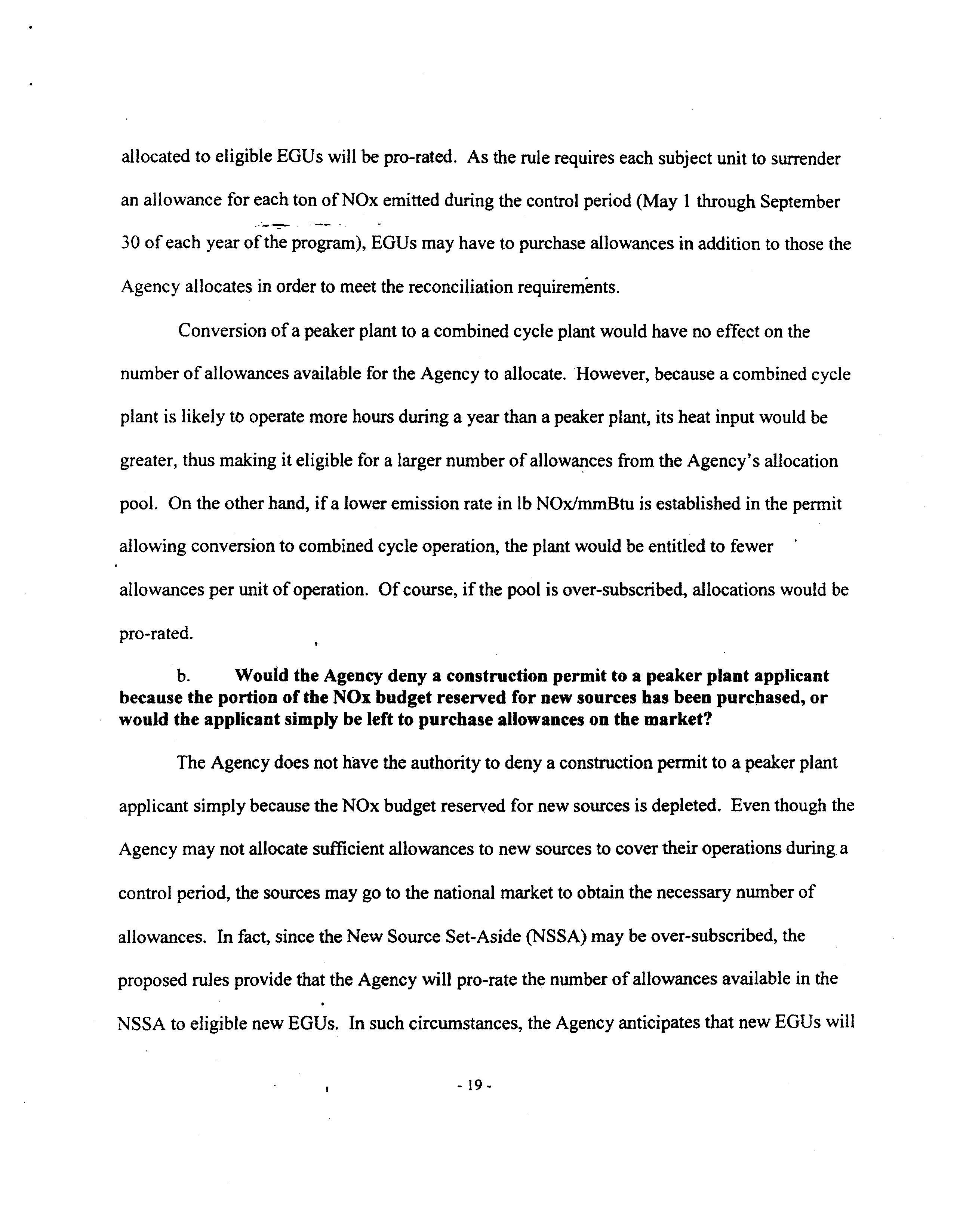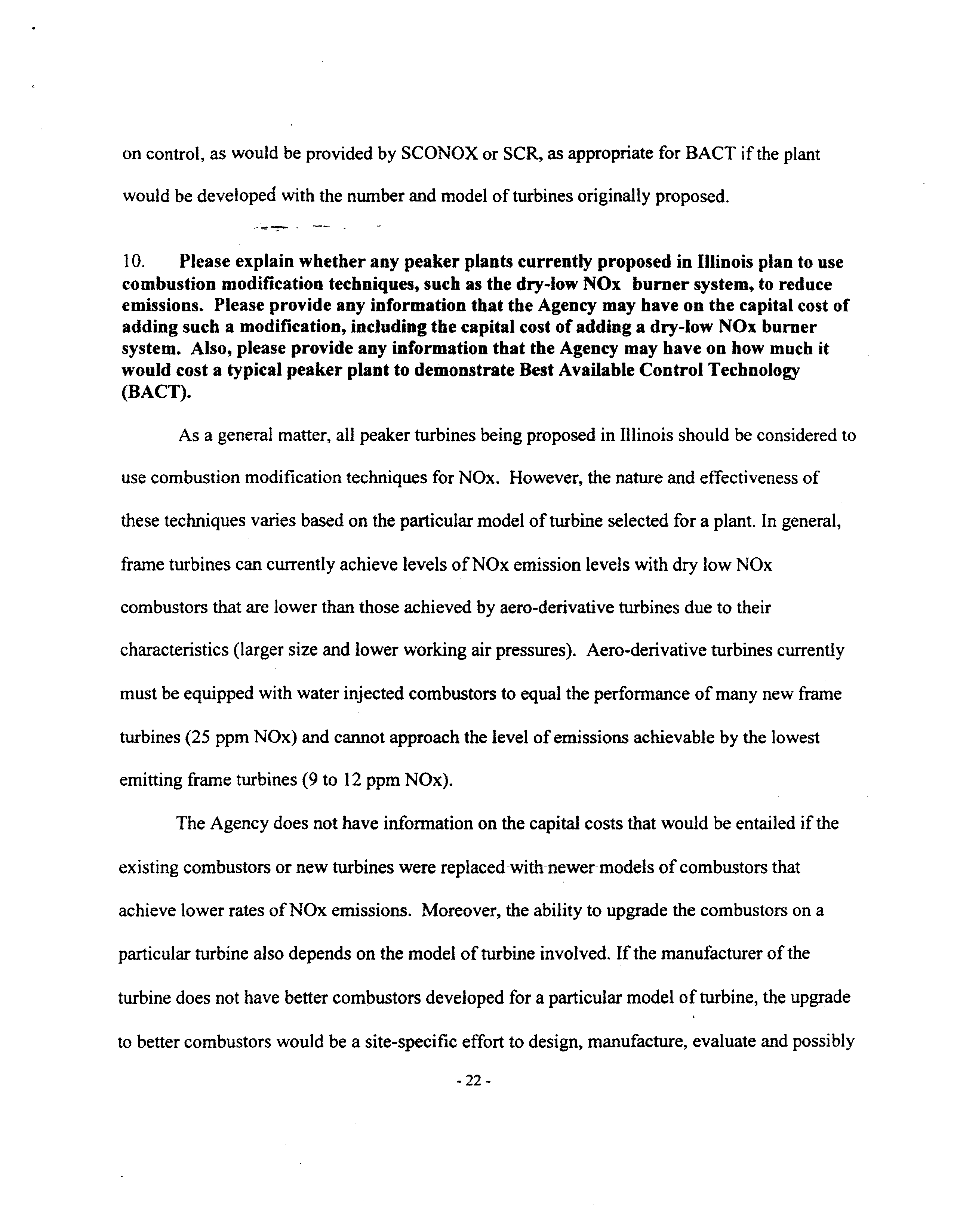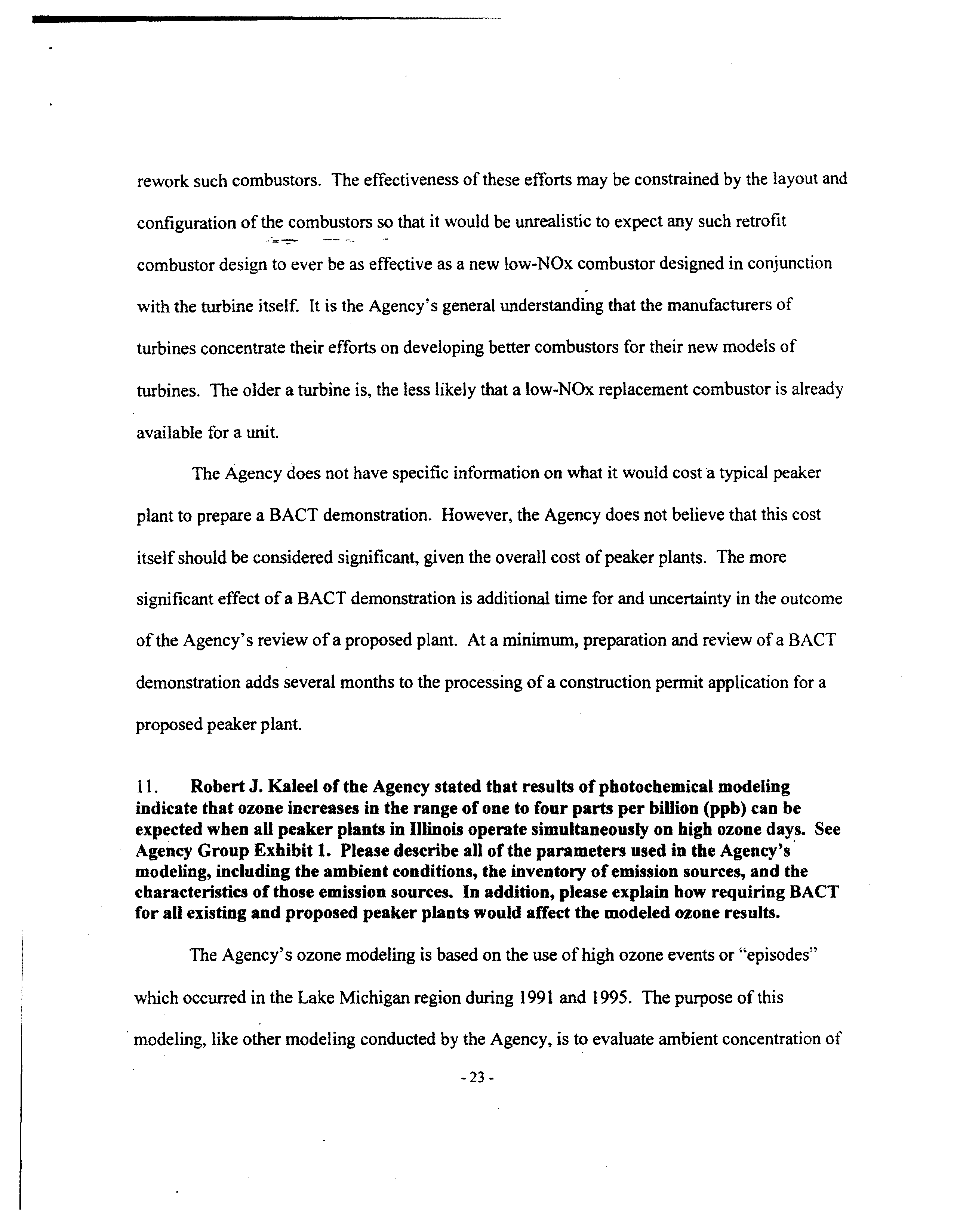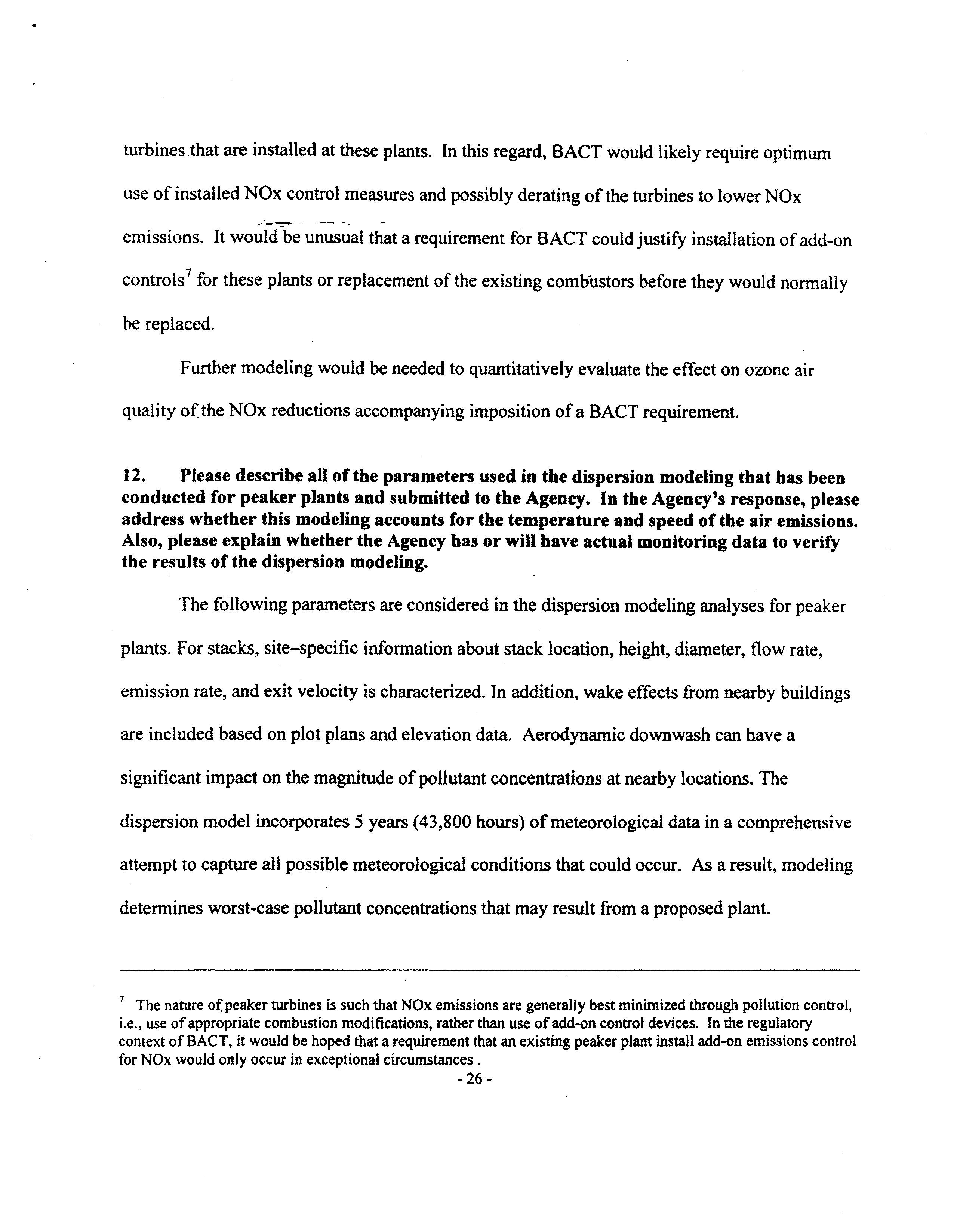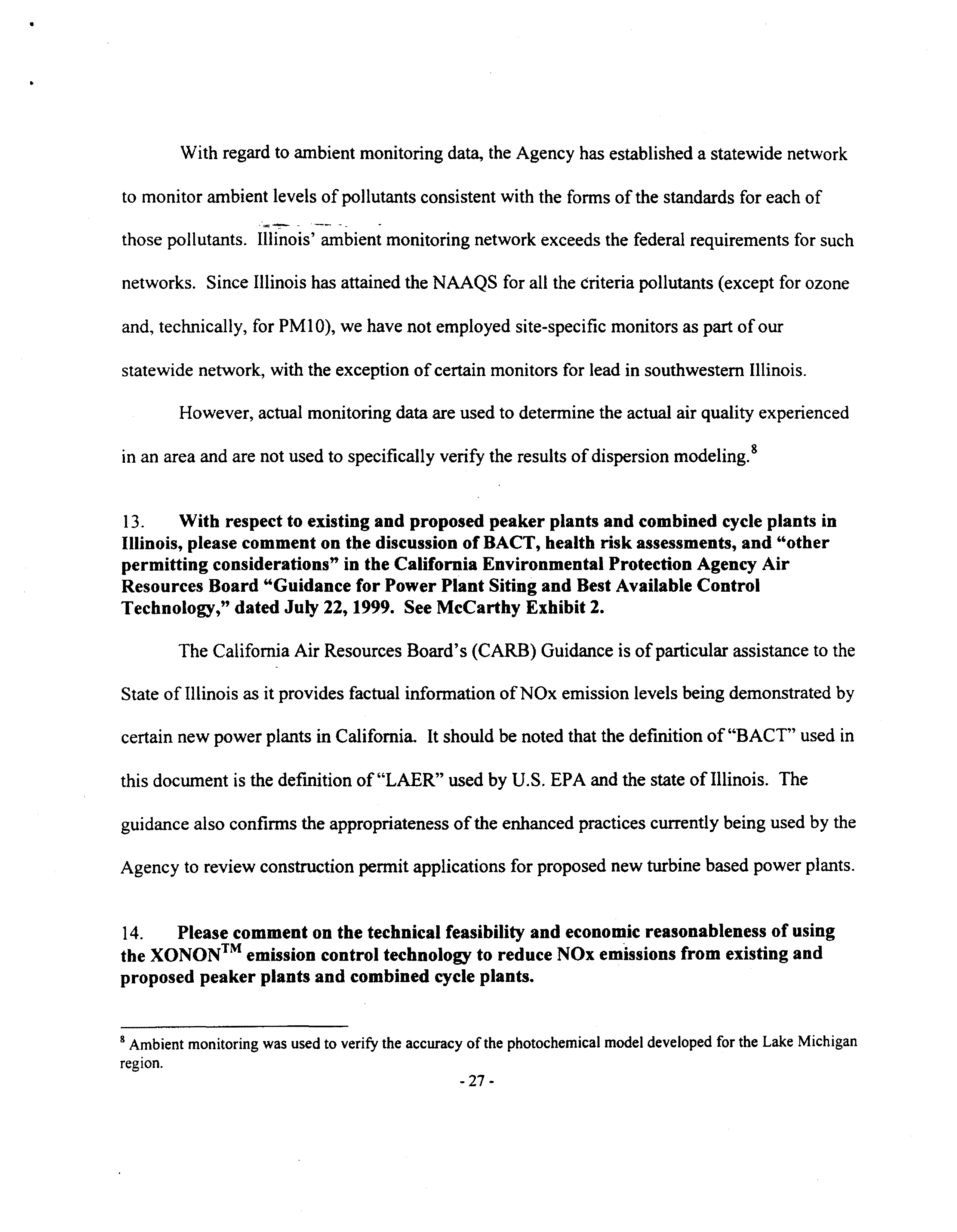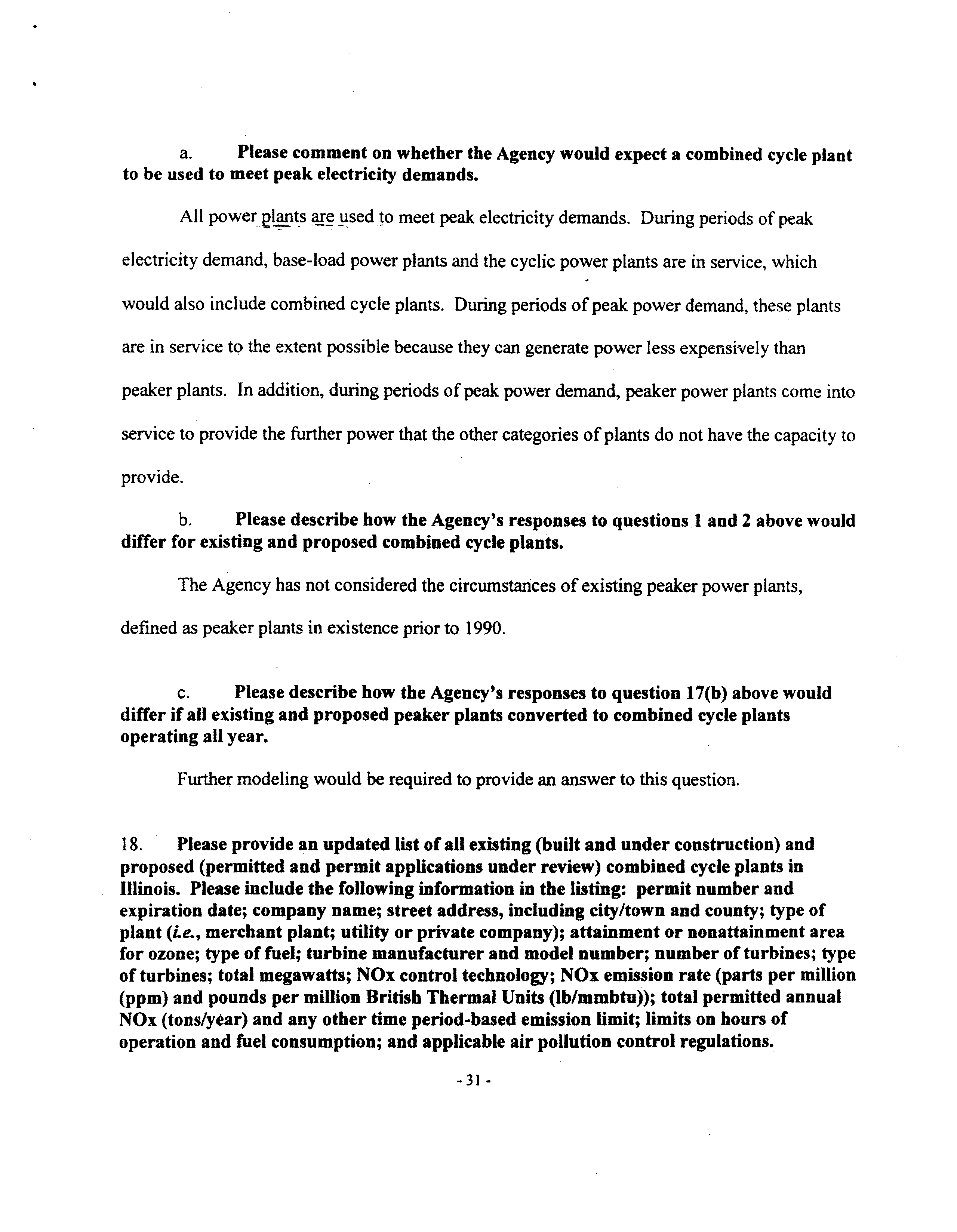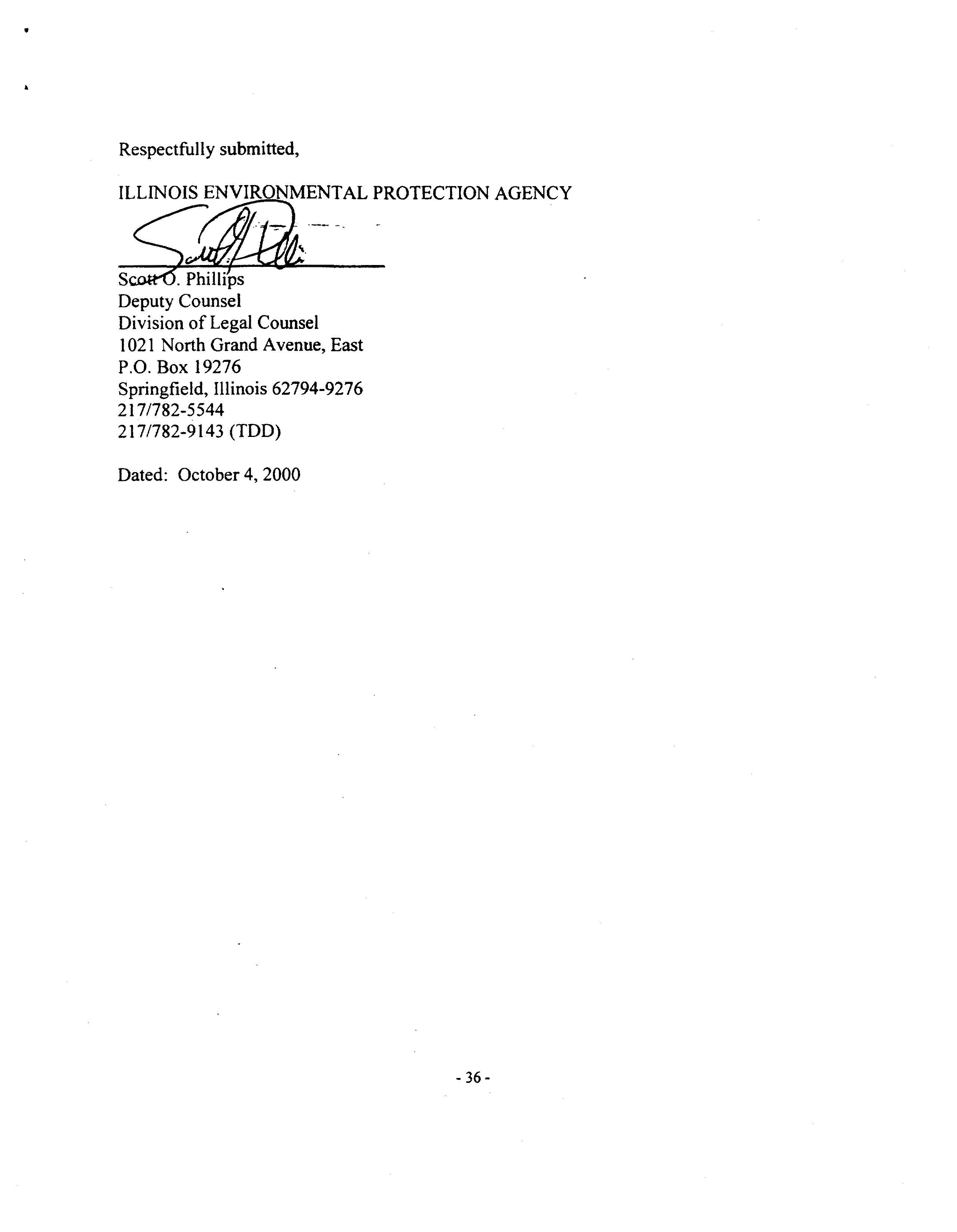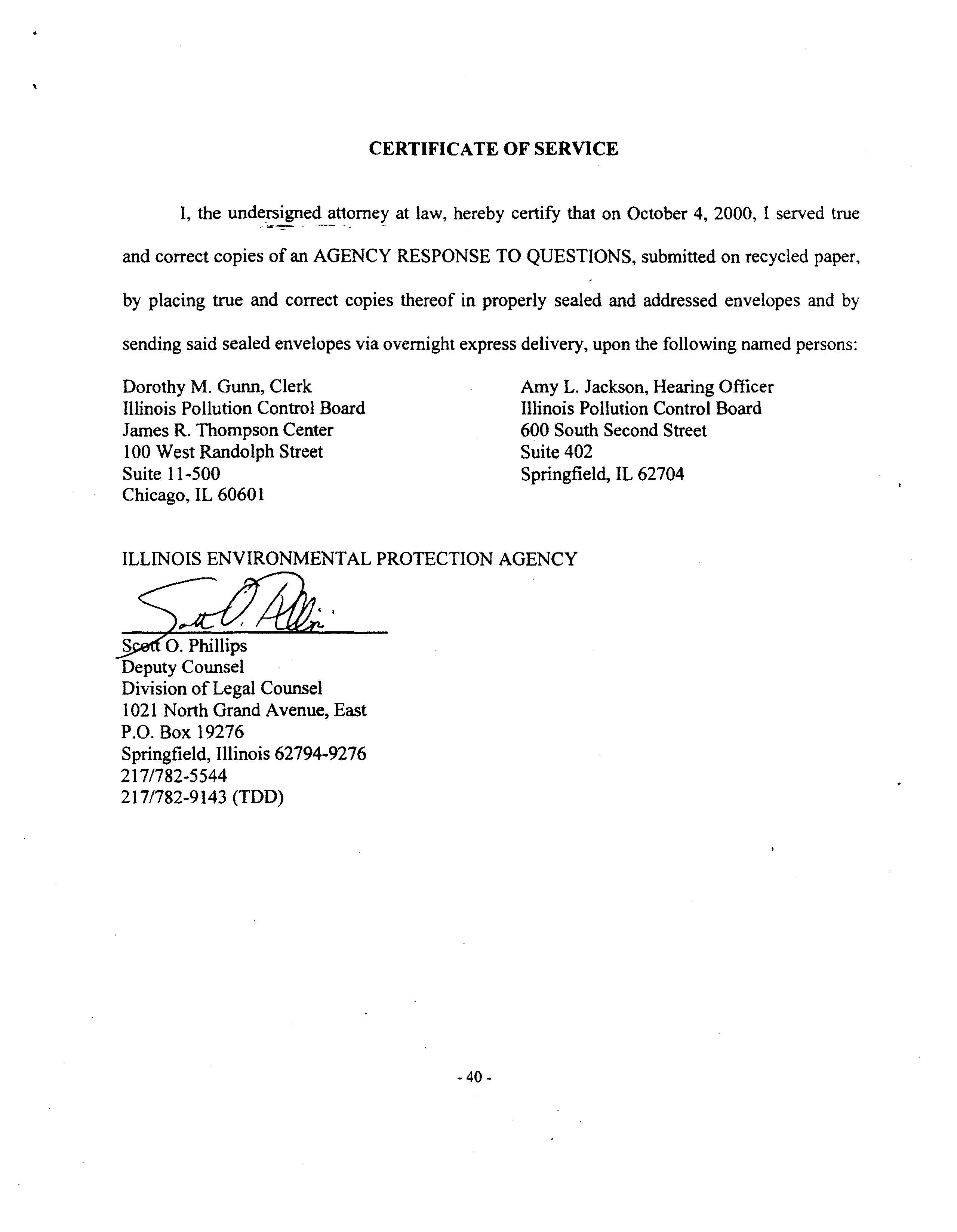BEFORE THE POLLUTION CONTROL BOARD
OF THE STATE OF ILLINOIS
IN THE MATTERQF:
NATURAL GAS-FIRED, PEAK-LOAD
ELECTRICAL POWER GENERATING
FACILITIES (PEAKER PLANTS)
Dorothy M. Gunn, Clerk
Illinois Pollution Control Board
James R. Thompson Center
100 West Randolph Street
Suite 11-500
Chicago, IL 60601
)
)
)
PCBNo.R01-10
)
)
NOTICE
Amy L. Jackson, Hearing Officer
Illinois Pollution Control Board
600 South Second Street
Suite 402
Springfield, IL 62704
PLEASE TAKE NOTICE that I have today filed with the office of the Clerk of the Pollution
Control Board an AGENCY RESPONSE TO QUESTIONS, copies of which are herewith served upon
you.
Respectfully submitted,
AGENCY
Deputy Counsel
Division ofLegal Counsel
1021 North Grand Avenue, East
P.O. Box 19276
Springfield, Illinois 62794-9276
217/782-5544
217/782-9143 (TDD)
Dated: October4, 2000
This filing submitted on recycled paper.
BEFORE THE POLLUTION CONTROL BOARD
OF THE STATE OF ILLINOIS
IN THE MATTER OF:
)
)
NATURAL GAS-FIRED, PEAK-LOAD
)
PCB No;R01-10
ELECTRICAL POWER GENERATING
)
FACILITIES (PEAKER PLANTS)
)
AGENCY RESPONSE
TO QUESTIONS FROM THE HEARING OFFICER ORDER
DATED
SEPTEMBER 25, 2000
NOW COMES the Illinois Environmental Protection Agency (“Agency” or “Illinois
EPA”), by one of its attorneys, Scott 0. Phillips, Deputy Counsel, and, pursuant to the assigned
Hearing Officer’s order dated September
25,
2000, hereby responds to questions directed to the
Agency. The questions raised, and the Agency’s responses, are as follows:
1.
Please
explain whether existing air pollution control laws and regulations, including
Prevention ofSignificant Deterioration (PSD), New Source Review (NSR), and New Source
Performance Standards (NSPS), address the following concerns raised at hearing with
respect to air emissions from existing and proposed peaker plants:
a.
peaker plant
sitings
near residential areas or schools;
Siting is not addressed specifically by these rules. Rather, each ofthese rules was
developed to protect the environment in different ways.
The PSD rules are structured to protect ambient air quality in attainment areas from
significant deterioration in three ways. First, PSD minimizes impacts ofmajor projects by
subjecting them to best available control technology (BACT), as determined on a case-by-case
basis during issuance ofa construction permit. Second, as directly related to the air quality
impact of a major project, PSD requires an applicant for a construction permit for a major project
—1—
to conduct an air quality impact analysis. This analysis must show that a proposed project will
not cause or contribute significantly to a violation ofthe national ambient air quality standards
(NAAQS). The NAAQS are ambient standards established by U.S. EPA and reviewed
periodically by U.S. EPA pursuant to the Clean Air Act. Therefore, when PSD applies, the air
quality should never degrade to a level where it violates the NAAQS as a result ofthe proposed
project. Third, the PSD rules establish air quality increments for particulate matter (PM), sulfur
dioxide (SO2), and nitrogen dioxide (NO2) but measured as nitrogen oxides (NOx). Increments
are fixed levels of deterioration in air quality in an area from the levels that exist when the first
majorproject subject to PSD is applied for in the area. In areas where air quality is significantly
better than the NAAQS, the increments may be constraining, so that air quality levels can never
reach the NAAQS. The location ofa proposed source near residential areas or schools would not
be a specific factor in issuance ofthe PSD permit, as the PSD rules fully protect air quality
irrespective of the land uses currently in an area.
The nonattainment NSR rules apply to major projects for a pollutant for which an area is
designated nonattainment. First, nonattainment NSR requires emissions ofthe nonattainment
pollutant to be controlled to the lowest achievable emission rate (LAER). Second, nonattainment
NSR requires emission offsets for the nonattainment pollutant so that there is an actual reduction
in overall emissions ofthe nonattainment pollutant in the nonattainrnent area. Because ofthe
regional nature ofozone, offsets for ozone precursors may be provided from anywhere in the
nonattainment area. Nonattainment NSR would operate only to protect or improve air quality
locally if the particular nonattainment problem was local in nature. Because NOx is both an
-2-
ozone precursor and a criteria pollutant, NOx can be subject to both PSD and nonattainment
NSR. This is the case in the Metro-East area, which does not have a NOx waiver for NSR. In
this area, NOx maybe subject to PSD as related to the NO2 NAAQS and subject to
nonattainment NSR as an ozone precursor. Again, local siting issues are not considered.
The NSPS are federal emission standards that apply to various types of emission sources.
The purpose ofthe NSPS is to ensure that state-of-the-art equipment, as ofthe date of
promulgation of the NSPS, is being employed when new emission sources are being installed
regardless of the state or area where the source is proposed. As such, the NSPS do not consider
the location of a project, nor do they address in any way the air quality impact ofa source. They
are simply federal technology-based standards applicable to any source for which NSPS have
been developed by U.S. EPA. Other case-by-case technology-based standards,
i.e.,
BACT and
LAER, may be more stringent than the NSPS, particularly with the passage oftime, as BACT
and LAER require evaluation ofthe most current technologies. However, BACT and LAER are
required of majorprojects only when PSD and NSR, respectively, have been triggered because
ofapplicable emissions thresholds.
b.
the clustering of peaker plants;
The air quality elements ofPSD address the clustering of peaker plants. In particular, a
major source proposing to develop at a site must consider the emissions and impacts of existing
sources already in the area and new sources also being developed in the area.
Nonattainment NSR and NSPS do not address clustering, as explained above.
c.
peaker plants emitting
up to annual limits on pollutants during the ozone
season;
-3-
Applicability ofthe NSPS to most emission sources, including turbines, is based on
source size or capacj~ythr_esholds. The NSPS for turbines applies to turbines with a heat input of
about 10 mmbtu or more (about 1 MWe output).
The Clean Air Act based applicability of PSD and nonattainment NSR on potential
emissions expressed on an annual basis. Considering emissions on a seasonal basis is a
relatively new concept. In fact, since adoption ofthe 1990 amendments to the Clean Air Act, the
Illinois EPA bad to go to great lengths to convince U.S. EPA ofthe appropriateness ofcertain of
the Board’s rules that require only seasonal emissions limitations. Since that time, U.S. EPA has
proposed the NOx SIP call (63 Fed.Reg.
57355
(October 27, 1998)), which requires additional
reductions ofNOx only during the so-called control period (May I through September 30) which
is a portion of the ozone season applicable in Illinois (April 1 through October 31). Moreover, as
NOx emissions have other impacts, unrelated to ozone, that are not seasonal in nature
(e.g.,
creation ofacid rain, eutrophication), it is not inappropriate that applicability of PSD be based on
annual emissions.
Once applicable, both PSD and nonattainment NSR do contain elements that address the
seasonal character ofa source. PSD requires appropriate air quality analyses to address the
relevant NAAQS. Thus, air quality impacts of peakerplants for PM, SO2, carbon monoxide
(CO) and ozone (VOM)’ must be evaluated on a short-term basis considering maximum short-
term emission rates, not annual average emission rates. Similarly, emission offsets under
nonattainment NSR would, have to provide comparable benefit to the period ofinterest,
i.e.,
-4-
summertime offsets to accommodate emissions of peaker plants, which will predominantly occur
during the summertime. In addition, under nonattainment NSR, stringent emission control could
be required with LAER to address the actual timing ofemissions.
d.
peaker plants emitting
greater amounts of pollutants during frequent
start-
ups and shut-downs.
The federal NSPS
require owners
or operators ofaffected sources to use good air
pollution practices in addition to establishing emission limits. Accordingly, while the NSPS
emission limit does not apply to an affected turbine during start-up and shut-down, the owner or
operator of a turbine subject to the NSPS must take reasonable measures to minimize emissions
during such periods. (See 40 CFR 60.8(c) and 60.11(d).)
PSD
and nonattainment NSR also address emissions during start-up and shut-down.
First, emissions during start-up and shut-down are considered as part ofthe total emissions ofa
peaker plant or other source for purposes ofapplicability. Second, PSD and nonattainment NSR
both can establish appropriate provisions to minimize emissions as part
ofa BACT or
LAER
determination. Third, the air quality analyses ofPSD must specifically address emissions during
start-up and shut-down as needed to protect air quality standards that apply on a short-term
hourly or daily average.
2.
Please address whether any localized impacts
(e.g.,
potentially exposing local
residents to greater amounts ofair pollutants) present a health concern with respect to air
emissions from
existing
and proposed peaker plants sited or to be
sited
near residential
areas or schools.
In attainment areas for ozone, a proposed major source subject to PSD for emission of VOM must evaluate the
affect of its VOM emissions on continued compliance with the~zone-NAkQS,which applies on a daily basis.
-5-
The Agency has required the applicants for proposed peaker plants, whether major or not,
to address expected air quality impacts ofexpected emission sources. The required analyses are
conservative (i.e., vôuld tend to overstate expected impacts), and address impacts at locations
where peak impacts are expected to occur, even as close as the source’s fence lines. The
modeling has consistently demonstrated that the air quality impacts ofthe peakers are small, if
not insignificant, and will not cause or contribute to violations ofthe NAAQS.
3.
In
permits
issued to peaker plants, please explain whether the Agency has limited,
other than
on an annual basis, the amount of pollutants that may be emitted, the number of
hours during which the plants may operate, and the amounts offuel that the plants may
consume
(e.g.,
daily,
weekly, monthly,
or seasonal
limits).
Please explain how theAgency
establishes permit
limits
on pollutant emission amounts, hours of operation, and fuel
consumption for peaker plants. In addition, please explain under what circumstances the
Agency would not impose a permit condition limiting the number ofhours duringwhich a
peaker plant may operate.
Construction permits issued to peaker plants routinely include (1) limitations on the
short-term (hourly) emission rates ofthe individual peaking turbines, and (2) restrictions on the
annual usage of fuel or operating hours of the turbines, in addition to (3) limitations on the
annual emissions of the plant. Annual limits are set on a rolling basis, so that compliance is
determined at least twelve times per year based on the sum of 12 consecutive months ofdata.
Separate weekly, monthly or seasonal limitations are not established.
The Agency has not imposed limitations on hours ofoperation on plants when the
applicant has proposed to accept restrictions on usage offuel. Because fuel usage can be directly
measured, the historical preference ofthe Agency in permitting has been to restrict fuel usage.
-6-
In considering how these limitations are developed, a brief review of the possible origin
oflimitations or restrictions imposed by permit conditions is in order. Certainly, permits may
contain limitations that result from evaluations or analyses prepared for the proposed project or
the particular circumstances ofthe project. Emission limitations and other requirements
determined to constitute BACT or LAER for a proposed turbine are one example of such
limitation. These “BACT/LAER limits” are established by the Agency pursuant to specific
regulatory provisions. Permits may also contain limitations or requirements that are established
under the Agency’s general authority to impose conditions in permits as necessary to protect air
quality and prevent air pollution. Permits may also contain provisions that merely restate
regulatory limits or standards. An example of a “restated limitation” is the restatement in
permits ofthe emission standard ofthe federal NSPS for gas turbines.
Equally important, construction permits also contain limitations that reiterate and hold an
applicant to significant representations made in its application. A common example ofsuch
“application-based limitations” are conditions restricting an emission unit to use ofthe fuels
described in its application. Application-based emission limitations are also routinely placed in
permits, holding an emission unit to the maximum levels of emissions that were represented in
the application.
In addition, permits may contain provisions that clarify, refine, revise, or otherwise
enhance applicable regulatory requirements, consistent with the Agency’s general authorities to
impose or allow such enhancements. Such “enhancing conditions” are routinely placed in non-
major permits as needed to fully address applicability of PSD or nonattainmentNSR. Conditions
7-
limiting annual emissions of a proposed plant would be considered such an “enhancing
limitation” if an applicant did not specify requested levels ofannual emissions in its application.
Similarly, if an applicant did identify requested levels ofannual emissions for a proposed minor
plant but did not accompany them with an associated level of operation, in terms ofannual fuel
consumption or hours ofoperation, the Agency would impose a limitation on fuel consumption
orhours of operation in the issued permit.
The emission limitations and operating restrictions imposed by the Agency on peaker
plants are a mix of application-based limitations and enhancing limitations, as discussed above.
As part ofthe preparation ofa construction permit, the Agency must address applicability of
PSD and nonattainment NSR. For a proposed non-major source, this is done by establishing
limitations on various aspects or dimensions ofa proposed plant, i.e., short-term (hourly)
emission limitation of individual turbines, limitations on the annual emissions ofall turbines at a
plant, and restrictions on the hours ofoperation or fuel usage ofa facility. Ideally, all these
limitations are application-based limitations reflecting data explicitly provided in the application
by the applicant to demonstrate that the proposed facility will not exceed the applicability
thresholds for a major source. In any event, the applicant must provide the basic data for short-
term emissions for the particular model ofturbine that has been selected for a project. The short-
term limitationsApplicantsin
arethe alsopermitrequiredreflecttothisprovidedata
providedinformationin theonapplication.maximum2hours
o-f-operation-or
fuel usage ofthe proposed plant along with their calculation forthe permitted annual emissions
..g
ofpollutants being requested for a proposed plant, to show how the proposed plant will be non-
major. This requires that the applicant provide its projection forthe relationship between
emissions and hours of operation or fuel usage. If the Agency disagrees with the particular data
points selected by the applicant for this calculation ofannual~missions or believes that it
provides an insufficient safety margin for status as a non-major project, the Agency will adjust
the results downward to address these points.
The exact process differs from application to application for a number of reasons. First,
different models ofturbines do exhibit variations in emissions based on turbine load, ambient
temperature, and use ofinlet air cooling. Second, the individual plants vary in terms of the
number ofturbines selected by the developer. Third, the approach to calculating annual’
emissions differs between applications.3 Finally, the Agency’s review of applications
accommodates variability in the approach to emissions taken by the applicant. In this regard, the
Agency has not attempted to standardize the way in which applicants approach emissions, nor is
it appropriate to do so. The purpose of Agency review ofa construction permit application is to
determine whether the application submitted for a proposed source demonstrates that it is being
developed to comply with applicable regulatory requirements.
2
~ the short-term emission rates provided in the application were natator below applicable regulatory limits, i.e,
the NOx emission standard of the federal NSPS forgas turbines, 40 CFR 60 Subpart
GO,
the application would be
denied.
~ In general, it appears that the smaller the plant, the simpler the approach used by applicants when calculating
annual emissions. That is, a sithpler, more conservative approach can be used to show that the emissions of a
proposed facility will be below major source thresholds while still allowing for a level ofpotential operation that is
desired for the proposed plant. Applicants for larger plants must use more complexapproaches for the calculation
of annual emissions to achieve the potential level ofoperation desired bra plant.
-9-
4.
Please explain whether the Agency limits
in air permits the types
of fuel that a
peaker plant may use. Please explain whether the emission limits
in
an air permit for a
peaker plant would vary depending upon the type of fuel used.
The Agency limits the types of fuels that a turbine may use to the fuels addressed by the
application (application-based limitations). In addition, if a particular turbine is being developed
with the capacity to bum both natural gas and oil, the Agency would establish separate short-
term emission limitations for the firing ofeach fuel (application-based limitations). Operating
restrictions would also be established for the firing ofeach fuel (application-based limitations or
enhancements). If use of oil was described as backup fuel in the application, these limitations,
which would be intended to assure that oil would not be used as the primary fuel.
Ifand when the turbine was built, the Permittee would have to demonstrate that the
turbine complies with both sets ofemission limits. On a continuing basis, it would have to
manage use offuel to comply with applicable operating restrictions.
5.
Please explain what notification requirements apply to the Agency and the applicant
when an air permit application for a peaker plant
is
submitted. Likewise, please explain
the notification requirements when the Agency holds hearings on such permit applications.
In the Agency’s response to these questions, please address whether notice
is
provided to
residents, schools, and any aeronautical authorities, such as the Federal Aviation
Administration, the Illinois Department of
Transportation,
and local
airports.
Also, please
describe the distance from the proposed site within which one must be located to be entitled
to notice.
The procedures for public notice and comment for air permits are found at 35 Ill. Adm.
Code 252. These procedures apply to the proposed issuance ofconstruction permits for new
major sources under nonattainment NSR and PSD, and for new sources that will not be
considered major because net emissions over a contemporaneous -period are not significant or
-10-
because significant restrictions are placed on the source’s proposed operations. In the case of
proposed new peaker plants, the Director has decided that the Agency will provide public notice
for all plants, regar’ZfTë~’sso1~e. The same procedures apply formajor and non-major
applications.
Part
252
requires that a notice be placed in a newspaper ofgeneral circulation in the area
where the source is located to notify the general public. In addition, the following entities must
be notified:
-
local government air pollution control offices within Illinois that are in the area
affected by the source;
-
chief executives of the county in which the source is to be located, including the
state’s attomey;
-
chief executive ofthe municipality in which the source is to be located, including the
mayor or president and clerk;
-
members ofthe General Assembly from the legislative district in which the source is
located;
-
any state whose air quality may be affected and which is contiguous to Illinois or
which is within
50
miles ofthe proposed source;
-
the permit applicant; and
-
persons on the public participation mailing list for the air pollution permit program.
Even though not required by rule, the Bureau of Air notifies other municipalities that are within a
3-mile radius ofthe proposed location.
Notices are not sent to individual property owners within a specified distance of a
proposed source. Any person or organization can request to be on the mailing list. Other state
*
II
—
agencies, such as IDNR, have requested to be on the mailing list. The notice forpublic comment
includes:
-
the name and address of the applicant;
-
the location ofthe proposed source, if different from the applicant’s address;
-
the activity or activities involved in the permit action;
-
for a proposed siguificant modification, a description ofthe change in the amount or
character of the emissions which may result from the modification;
-
the preliminary decision ofthe Agency to grant the permit;
-
for the issuance of a PSD permit, the degree of ambient air increment consumed by
the project;
-
for a case-by-case MACT determination pursuant to Section 112(g) and Section
112(j) of the CAA, a description ofthe emission limitation or work practice standard
in the draft permit that constitutes MACT;
-
the location ofthe documents available for public review;
-
a request for written comments on the Agency’s draft proposed permit;
-
the date by which comments must be postmarked, which provides at least 30 days for
public comment;
-
instructions on how to request a public bearing if a decision to hold a hearing has not
already been made pursuant to Section
252.205(a)
or (b); and
-
the name, address, and telephone number ofthe Agency contact person from whom
the public may obtain additional information.
Along with the notice, the Agency prepares and makes available to interestedparties the draft
permit and a project summary (fact sheet).
The public comment period is open for 30 days.
12
-
The procedures for public notice when a hearing is being held axe the same as above with
the following
-
the commentenhancements:period4~is open forat least
45
days prior to the hearing and at least 15 days
after the hearing;*
-
persons on the Agency’s hearing mailing list are added to the air pollution control
permit program mailing list;
-
the information is made available at a local repository, usually a local library; and
-
the public notice is published in a local paper once a week for three consecutive weeks.
• The hearing officer has the authority to shorten the 30 days of comment after the
hearing.
6.
Please explain whether the Agency expects peaker plants to emit, during start-up
and shut-down, greater amounts of air pollutants than at other times ofoperation. Please
address whether Illinois air permits for peaker plants should include special provisions to
control air emissions during start-up and shut-down. In addition, please explain whether
the Agency expects peaker plants to emit greater amounts of
air
pollutants at lower load
levels. Please address whether Illinois air permits for peaker plants should include special
provisions to contrOl air emissions during lower load operations.
The Agency expects gas turbines to emit greater amounts ofpollutants during startup and
shutdown to the extent that emissions ofpollutants are related to combustion efficiency (CO and
VOM) or “active” control measures (NOx, when controlled by water injected or dry low-NOx
combustors or SCR). In particular, the combustion efficiency of a turbine will be at its lowest
when the fuel is first ignited and the combustion reaction is being established in the combustor.
Likewise, the techniques that are used to lower NOx emissions are not effectively applied until
flows and temperatures in the combustor or turbine exhaust reach certain minimum levels.
“The hearings themselves are held in accordance with
35
III. Adm. Code 166: Subpart A.
-
13
-
These effects are such that emissions certainly are higher when expressed as an emission
factor, (e.g., pounds of pollutant emitted per million Btu heat input to the turbine). However,
emissions may n6fi~higherwhen expressed in pounds per hour, as the lower load (heat input)
during startup and shutdown compensates for the higher emission factor. The extent ofthe
actual increases in emissions depends upon the performance of the particular model ofturbine.
The extent ofthe perceived increases also depends upon the precision ofthe emission data
submitted in a permit application. Ifthe application is conservatively developed with worst-case
emission rates, expressed in terms of pounds per hour, startup and shutdown emissions may not
be significantly different than emissions during normal operation. Ifthe emission data for
normal operation more exactly portrays the low levels of emissions occurring during normal
operation ofa particular turbine, the emissions during startup and shutdown are greater in
comparison. In this regard, the lower the emissions ofa turbine during normal operation, the
greater the emissions during startup and shutdown ofthe turbine appear.
For turbines, these higher levels ofemissions accompanying startup and shutdown occur
over relatively short periods oftime, i.e., 15 to 30 minutes, and do not appear to pose any
extraordinary concern for air quality impacts. Startup and shutdown emissions from turbines,
like higher emissions during startup and shutdown of many emission units, are simply another
aspect ofthe variation in emissions ofparticular emission units that must be appropriately
addressed during permitting.
The construction permits now being issued by the Agency do make clear that a peaker
plant must account for all its emissions, including emissions during startup and shutdown, when
-14-
demonstrating compliance with annual emission limits. Construction permits also have
provisions requiring peaker plants to implement measures to minimize emissions ofthe turbines
associated with starti.ip and shutdown. These provisions are general in nature and would be
subject to further refinement based on actual operating experience when operating permit
applications are processed. The permits do not have specific limitations on the amount of
emissions during startup and shutdown. Such provisions may be appropriate for cases where the
elevated emissions ofan emission unit during such periods would threaten air quality or when
startup procedures can vary greatly due to unique aspects ofindividual startups. These are not
the circumstances for peaker turbines, where startup is a rapid, automated process.
The Agency also expects gas turbinesto emit greater amounts ofCO and VOM during
low load operation as combustion efficiency ofturbines frequently goes down with low load
operation.5 Like startup and shutdown, these effects are such that emissions would be higher
when expressed as an emission factor. However, emissions may not be higher when expressed
in pounds per hour, as the reduction in load (heat input) compensates for the higher emission
factor. The extent ofthe actual increase again depends upon the performance ofthe particular
model ofturbine and how consistent its performance is over its normal load range. The extent of
the perceived increases also depends upon the precision ofthe emission data submitted in the
application. Ifan application is conservatively developed with worst-case hourly emission rates
and emission factors, turbine load may not be a consideration in setting appropriate short-term
emissions limits forthe turbine.
-
15-
Construction permits are developed with appropriate provisions to address variations in
turbine emissions with load. Emission testing is required over the normal operating range ofthe
turbine. Separate h~rt-téi~ihemisiion limits are set for reduced load operation if needed.
Finally, restrictions on operation at reduced load are set if needed to protect ambient air quality
(See also Question
15).
7.
Please comment on whetherthe United States Environmental Protection Agency
(USEPA) should revoke the nitrogen oxides (NOx) waiver with respect to Illinois. In the
Agency’s response, please address the following:
The removal of the NOx waiver would have ramifications that are well beyond the scope
ofthis proceeding. Therefore, the NOx waiver should not be revoked based solely on pèaker
plants.
As stated in the Agency’s testimony, current modeling shows that emissions from
currently permitted and proposed peaker plants will not interfere with the area’s ability to attain
the ozone NAAQS. The decision on the NOx waiver should be made by U.S. EPA in the context
of its review ofthe attainment demonstration for the Chicago area.
To the extent that reducing emissions from peakers is deemed appropriate, these
reductions can be accomplished through the imposition of control measures that are more
appropriate to address this group of sources rather than by the revocation ofthe NOx waiver.
In the Agency’s response, please address the following:
~ Within the normal operating range ofa turbine, where NOx control measures are effective, NOx emissions are
generally consideredto be greatest at maximum load. As load on the turbine is reduced, NOx emissions also go
down.
-16-
a.
the implications for NOx emitters, including existing and proposed peaker
plants, if USEPA revokes the NOx waiver;
If the Chicag2~Legal Clinic’s petition for revocation ofthe NOx waiver forNew Source
Review (NSR) were granted, it would have no effect on existing and currently permitted peakers
as there would be no retroactive effect. If NSR became effective prior to issuance ofan air
pollution construction permit, a proposed peakers with the potential to emit (PTE) of25 tons per
year (TPY) or more ofNOx would have to demonstrate that its NOx emissions would meet the
lowest achievable emission rate (LAER). Applicants would also need to demonstrate that its
potential NOx emissions would be offset by a 1.3:1 ratio ofemission reductions upon
commencing operation.
b.
the
Ozone Transport Assessment Group (OTAG) findings on NOx and
USEPA’s NOx State Implementation Plan (SIP) call; and
The NOx waiver granted for the Lake Michigan area recognized that OTAG was
conducting an extensive evaluation of regional ozone transport and its causes and solutions.
Therefore, the waiver was granted on a contingent basis and would be re-examined in the context
ofthe attainment demonstrations submitted by the Lake Michigan states for the area. In general,
the findings ofOTAG addressed the impacts ofregional NOx emission reductions and did not
specifically address local impacts that may result in a NOx disbenefit.
The NOx SIP Call specifically provides that it does not impact any NOx waiver a state
may have been granted. Also, the NOx waiver does not bar a state from imposing control
measures on NOx sources as necessary for the state to demonstrate attainment with the 1-hour
ozone standard or to address ozone transport.
-
17-
c.
any relationship
between the
NOx waiver and USEPA’s cap on NOx
emissions for Illinois under the SIP call, including any anticipated impact on the cap
if
USEPA revokes the NOx waiver.
The NOx waiver did not impact the setting ofthe State’s NOx emissions cap and, thus, if
U.S. EPA revokes the NOx waiver, it will not impact the cap: Further, the NOx waiver does not
bar a state from imposing control measures on NOx sources as necessary for the state to
demonstrate attainment with the 1-hour ozone standard. However, removal ofthe NOx waiver
may limit NOx emissions from new stationary sources.
The NOx SIP Call specifically provides that it does not impact any NOx waiver a state
may have been granted. The NOx emissions cap imposed upon the State under the NOx SIP
Call, subject to trading, will control growth ofNOx emissions.
8.
In the
rulemaking pending
before the Board docketed
as
RO1-9, Proposed
New
35
Ill.Adm.Code 217.Subpart W, the NOx Trading Program for Electrical Generating
Units,
and Amendments to 35 Ill.Adm.Code 211 and 217, the Agency has proposed a NOx
emissions budget of30,701 tons per ozone season for electrical generating units (EGUs),
based upon USEPA’s NOx emissions cap for Illinois under the SIP call.
a.
Please describe how the NOx budget would impact existing and proposed
peaker plants. In addition, please explain what this impact would be if all ofthose peaker
plants converted to combined cycle plants operating all year.
The NOx allowances available for distribution in Illinois will be based upon actual heat
input,
i.e.,
a plant’s historical operation. As the number of allowances for the state is capped at
30,701 tons per season, the Agency can allocate no more than that number. Therefore, more or
fewer peaker plants will not affect the number of allowances that the Agency will allocate. More
or fewer peaker plants may affect the number ofallowances allocated to any given plant,
however. Ifthe pool of allowances available for EGUs is over-subscribed, then the allowances
-18-
allocated to eligible EGUs will be pro-rated. As the rule requires each subject unit to surrender
an allowance for each ton ofNOx emitted during the control period (May 1 through September
30 ofeach year ofthe program), EGUs may have to purchase allowances in addition to those the
Agency allocates in order to meet the reconciliation requirem~nts.
Conversion ofa peaker plant to a combined cycle plant would have no effect on the
number ofallowances available for the Agency to allocate. However, because a combined cycle
plant is likely to operate more hours during a year than a peaker plant, its heat input would be
greater, thus making it eligible for a larger number ofallowances from the Agency’s allocation
pool. On the other hand, if a lower emission rate in lb NOx/mmBtu is established in the permit
allowing conversion to combined cycle operation, the plant would be entitled to fewer
allowances per unit ofoperation. Of course, if the pool is over-subscribed, allocations would be
pro-rated.
b.
Would the Agency deny a construction permit to a peaker plant applicant
because the portion
ofthe NOx budget reserved for new sources has
been
purchased, or
would the applicant simply be left to purchase allowances on the market?
The Agency does not have the authority to deny a construction permit to a peaker plant
applicant simply because the NOx budget reserved for new sources is depleted. Even though the
Agency may not allocate sufficient allowances to new sources to cover their operations during, a
control period, the sources may go to the national market to obtain the necessary numberof
allowances. In fact, since the New Source Set-Aside (NSSA) may be over-subscribed, the
proposed rules provide that the Agency will pro-rate the number ofallowances available in the
NSSA to eligible new EGUs. In such circumstances, the Agency anticipates that new EGUs will
-19-
either manage their operations to match the number of allowances they were issued or that they
will go to the market to purchase any additional allowances to enable them to meet their
reconciliationrequii~rnents.
-,
c.
Please describe any anticipated impact on allowance allocations in Illinois if
USEPA revokes the NOx waiver.
Revocation ofthe NOx waiver would have no impact on the number of allowances
available for allocation in Illinois.
9.
Please explain what would constitute the Lowest Achievable Emission Rate (LAER)
for peaker plants and for combined cycle plants. In the
Agency’s response, please address
the control technology in Standard Power and Light’s draft permit application, including
its
technical feasibility and economic reasonableness. See Standard Power and Light
Exhibit 1.
Lowest Achievable Emission Rate (LAER) is determined on a case-by-case basis for a
particular project. Nevertheless, because ofthe stringent nature ofLAER, which requires the
emissions rate to be set at the most stringent emission limit required of or achieved by another
similar source, it is easier to speculate on what would currently be considered LAER for different
types ofplants.
LAER for a peaker turbine would almost certainly require use ofadd-on control for
emissions ofNOx. This is based on available information, such as the California Air Resources
Board (CARB) Power Plant Guidance Document that indicates that add-on control systems are
being used on at least a handful ofpeaker turbines in California. The only exception that might
apply is to a “peaking” peaking turbine, perhaps a portable turbine that would only operate for
only a very limited period of time when all other peaking resources were being utilized. The
-20-
associated emission limit for NOx for normal operation ofthe turbine with the add-on control
device would be no greater than
5
ppm, based on the performance ofsuch systems reported by
CARB.
LAER for a combined-cycle turbine would certainly require use ofadd-on control for
NOx. Add-on control devices are routinely used on new combined cycle power plants
throughout the country. The associated emission limit for NOx for normal operation of the
turbine with the add-on control device would be no greater than
2.5
ppm, based on the
performance of such systems reported by CARB.
The Agency is not in a position to comment on the technical feasibility and economic
reasonableness of the SCONOX~control system now being proposed by Standard Energy
Ventures for its proposed plant in West Chicago. However, the proposed add-on control system
will likely be found to satisfy
BACT for
peaker turbines as required for the proposed plant, as it
would potentially be’ a major source for emissions ofNOx. The proposed system would also be
likely to be found to satisfy LAER at this time. Ifthe proposed plant is developed with
SCONOX’~,the feasibility of this type ofcontrol system will have been demonstrated in Illinois
for the turbines on which it has been installed. Standard Energy Venture’s initial application
proposed to install 32 “small” peaker turbines each with a capacity of25 MW, with a proposed
NOx emission limit set at
25
ppm as achieved with water injectedcombustors. The application
did not demonstrate that another selection ofturbines could not reasonably be made that would
result in lower emissions ofNOx overall. Accordingly, the Agency required some form ofadd-
-21-
on control, as would be provided by SCONOX or SCR, as appropriate for BACT if the plant
would be developed with the number and model of turbines originally proposed.
10.
Please explain whether any peaker plants currently
proposed in Illinois plan to use
combustion
modification techniques, such as the dry-low NOx burner system, to reduce
emissions. Please provide
any
information
that
the Agency may have
on
the capital cost of
adding
such a modification, including the capital cost
ofadding a dry-low NOx burner
system. Also, please provide any
information that the Agency may have on how much it
would cost a typical peaker
plant
to demonstrate Best Available
Control
Technology
(BACT).
As a general matter, all peaker turbines being proposed in Illinois should be considered to
use combustion modification techniques forNOx. However, the nature and effectiveness of
these techniques varies based on the particularmodel ofturbine selected for a plant. In general,
frame turbines can currently achieve levels ofNOx emission levels with dry low NOx
combustors that are lower than those achieved by aero-derivative turbines due to their
characteristics (larger size and lower working air pressures). Aero-derivative turbines currently
must be equipped with water injected combustors to equal the performance ofmany newframe
turbines (25 ppm NOx) and cannot approach the level of emissions achievable by the lowest
emitting frame turbines (9 to 12 ppm NOx).
The Agency does not have information on the capital costs that would be entailed if the
existing combustors or new turbines were replacedwith-newermodels ofcombustors that
achieve lower rates ofNOx emissions. Moreover, the ability to upgrade the combustors on a
particular turbine also depends on the model ofturbine involved. Ifthe manufacturer ofthe
turbine does not have better combustors developed for a particular model ofturbine, the upgrade
to better combustors would be a site-specific effort to design, manufacture, evaluate and possibly
-
22
-
rework such combustors. The effectiveness of these efforts may be constrained by the layout and
configuration ofthe combustors so that it would be unrealistic to expect any such retrofit
combustor design to ever be as effective as a new low-NOx combustor designed in conjunction
with the turbine itself. It is the Agency’s general understanding that the manufacturers of
turbines concentrate their efforts on developing better combustors for their new models of
turbines. The older a turbine is, the less likely that a low-NOx replacement combustor is already
available for a unit.
The Agency does not have specific information on what it would cost a typical peaker
plant to prepare a BACT demonstration. However, the Agency does not believe that this cost
itself should be considered significant, given the overall cost ofpeaker plants. The more
significant effect ofa BACT demonstration is additional time for and uncertainty in the outcome
ofthe Agency’s review ofa proposed plant. At a minimum, preparation and review ofa BACT
demonstration adds several months to the processing ofa construction permit application for a
proposed peaker plant.
11.
Robert J. Kaleel of the Agency stated that results ofphotochemical modeling
indicate that ozone increases in the range of one to four parts per billion (ppb) can be
expected when all peaker plants in Illinois operate simultaneously on high ozone days. See
Agency Group Exhibit 1. Please describe all ofthe parameters used in the Agency’s
modeling, including the ambient conditions, the inventory ofemission sources, and the
characteristics of those emission sources. In addition, please explain how requiring BACT
for
all
existing and proposed peaker plants would affect the modeled ozone results.
The Agency’s ozone modeling is based on the use of high ozone events or “episodes”
which occurred in the Lake Michigan region during 1991 and
1995.
The purpose ofthis
modeling, like other modeling conducted by the Agency, is to evaluate ambient concentration of
-23-
pollutants in the atmosphere. Meteorological and emissions data that represent those that
occurred during these specific periods are used in the modeling. The meteorological data for the
grid cells characteriies wind direction and speed, temperature, pressure, humidity, and
turbulence from the surface to several kilometers into the atmosphere for each time step
(typically 4 to 6 minutes). Cloud and precipitation fields are characterized from National
Weather Service observations. The model also contains a numerical chemical algorithm that
calculates all the chemical reactions expected from the interaction ofpollutants with the
meteorology.
The emissions inventory includes hourly emissions for volatile organic compounds
(VOC), oxides ofnitrogen (NOx), and carbon monoxide (CO) for each grid cell in the domain.
Emissions are included from anthropogenic (man-made) and biogenic (naturally occurring)
sources known to emit these compounds, including motor vehicles (both on-road and off-road),
industrial orpoint sources (smoke-stacks either low or elevated in height), area sources (fuel
combustion, commercial and consumer solvents, etc), and biogenic emissions (from plants, soil,
and other naturally occurring emission sources).
The Agency’s modeling ofthe peakers was based on LADCO’s future year, attainment
modeling. This modeling assumes both growth for each source category, and control based on
the NOx SIP Call and all other control measures anticipated by the attaimnent year, 2007. These
measures include Enhanced Inspection and Maintenance, Phase II— reformulated gasoline, Tier
2 automotive standards, low sulfur gasoline, standards on heavy-duty vehicles, and other
measures required by the Clean Air Act. Emissions were then included from all new peaker
-24
-
plants for which applications are active or permits have been issued as oflate July. Emissions
were also included for new combined cycle plants.
The Agency would expect the imposition ofa BACT requirement on existing and
proposed peaker plants to have, at most, a small effect on overall ozone air quality. Because
BACT is a case-by-case determination made during issuance ofa construction permit for a new
or modified emission unit, the Agency can only speculate on the extent to which a BACT
requirement for existing and proposed peaker plants would lower the NOx emissions of
individual plants, if at all. However, it should be remembered that some new peaker plants are
major sources and are already or will be subject to BACT pursuant to the federal PSD program.
Many other new peaker plants have installed the same models ofturbines or turbines achieving
similar NOx emission levels as have been formally been determined to constitute BACT for the
major sources. Existing peaker plants and new plants using existingturbines also would
probably be determined to have BACT as the turbines are operated infrequently and would be
particularly expensive to update with combustors emitting lower NOx.6 As a result, most peaker
plants would not be affected by a BACT requirement.
There are certainly some newly built peaker plants that could be affected by imposition of
a BACT requirement. However, the level ofNOx reduction that would be achieved by
imposition ofa BACT requirement on such plants would probably not be large. The available
reduction in NOx emissions at these potentially affected plants would be constrained by the
6
Cost-effectiveness is a consideration in a BACT determination.. The emission reduction accompanying further
control of a peaker turbine must generally be considered to be small because a peaker turbine is idle most of the
year, only operating during periods of peak demand or to supply power on an emergency basis. This is particularly
true for older units that are less efficient in converting fuel to electricity and thus the less desirable to operate.
-25-
turbines that are installed at these plants. In this regard, BACT would likely require optimum
use of installed NOx control measures and possibly derating ofthe turbines to lower NOx
emissions. It would be unusual that a requirement for BACT could justify installation of add-on
controls7 for these plants orreplacement ofthe existing combüstors before they would normally
be replaced.
Further modeling would be needed to quantitatively evaluate the effect on ozone air
quality ofthe NOx reductions accompanying imposition of a BACT requirement.
12.
Please describe all ofthe parameters used in the
dispersion
modeling that has been
conducted for peaker plants and submitted to the Agency. In the Agency’s response, please
address whether this modeling accounts for the temperature and speed ofthe air emissions.
Also, please explain whether the Agency has or will have actual monitoring data to verify
the results ofthe dispersion modeling.
The following parameters are considered in the dispersion modeling analyses for peaker
plants. For stacks, site—specific information about stack location, height, diameter, flow rate,
emission rate, and exit velocity is characterized. In addition, wake effects from nearby buildings
are included based on plot plans and elevation data. Aerodynamic downwash can have a
significant impact on the magnitude of pollutant concentrations at nearby locations. The
dispersion model incorporates
5
years (43,800 hours) ofmeteorological data in a comprehensive
attempt to capture all possible meteorological conditions that could occur. As a result, modeling
determines worst-case pollutant concentrations that may result from a proposed plant.
~ The nature of peaker turbines is such that NOx emissions are generallybest minimized through pollution control,
i.e., use of appropriate combustion modifications, rather than use of add-on control devices. In the regulatory
context of BACT, it would be hoped that arequirement that an existing peaker plant install add-on emissions control
for NOx would only occur in exceptional circumstances.
-
26
-
With regard to ambient monitoring data, the Agency has established a statewide network
to monitor ambient levels ofpollutants consistent with the forms ofthe standards for each of
those pollutants. Illinois’ ambient monitoring network exceeds the federal requirements for such
networks. Since Illinois has attained the NAAQS for all the criteria pollutants (except for ozone
and, technically, for PMIO), we have not employed site-specific monitors as part ofour
statewide network, with the exception ofcertain monitors for lead in southwestern Illinois.
However, actual monitoring data are used to determine the actual air quality experienced
in13.an areaWithandrespectare not
to
used
existing
to specifically
and proposed
verify
peaker
the results
plants
ofdispersion
and combined
modeling.
cycle
8
plants in
Illinois, please comment on the discussion of BACT, health
risk assessments,
and “other
permitting considerations” in the California Environmental Protection Agency Air
Resources Board “Guidance for Power Plant Siting and Best Available Control
Technology,” dated
July
22, 1999. See McCarthy Exhibit 2.
The California Air Resources Board’s (CARB) Guidance is ofparticular assistance to the
State of Illinois as it provides factual information ofNOx emission levels being demonstrated by
certain new power plants in California. It should be noted that the definition of“BACT” used in
this document is the defmition of”LAER” used by U.S. EPA and the state ofIllinois. The
guidance also confirms the appropriateness of the enhanced practices currently being used by the
Agency to review construction permit applications for proposed new turbine based power plants.
14.
PLease comment on the technical feasibility and economic reasonableness ofusing
the XONONTM emission control technology to reduce NOx emissions from existing and
proposed peaker plants and combined cycle plants.
‘Ambient monitoring was used to verif~’the accuracy ofthe photochemical model developed forthe Lake Michigan
region.
-27
-
XONON~catalytic combustion technology is a very promising combustion
modification technique forturbines. Unfortunately, the technology has not yet been developed
for the larger turbine~sbeing used in new power plants. Accordingly, while this technology is
certainly technically feasible in a general sense, it cannot be considered available for the projects
that are now being developed in Illinois.
15.
The Agency stated that it is, as a matter ofadministrative discretion, requiring
peaker plant applicants for air permits to conduct certain air modeling. Please explain
what actions the Agency has taken or might takewith respect to such an application based
on these modeling results.
The site-specific air quality analyses prepared forthe proposed peaker plants generally do
not result in the imposition ofadditional conditions in the construction permits issued for
proposed peaker plants. This is because the analyses generally show that the proposed plants
will not have impacts that threaten9 air quality and the proposed plants are held to the emission
levels represented by the applicants in their applications, irrespective ofthe specific preparation
ofthe air quality analyses.
If the air quality analysis demonstrated that a proposed plant could not be routinely
operated at the emission rates set forth in the application without threatening air quality, the
application would be denied.
If an air quality analysis identified a particular configuration ofturbine operation that
would threaten air quality, the permit would most likely contain a condition restricting that mode
°
For purposes of this discussion, a source is considered to threaten air quality if the result would threaten
continued attainment of the air quality standards. In many cases, the impact ofthe peakerplant is below USEPA’s
numerical “de minimis” impact levels. Ifthis is not the case for a pollutant, the modeled impacts ofthe proposed
source, the modeled impacts ofother significant existing and proposed sources in the vicinity ofthe proposed
-28-
of operation. An example of such a configuration might be low-load operation ofall turbines at
the maximum emission rates for low-load operation identified in the application. Rather than
restricting the partr~iarmode ofoperation outright, the more likely approach would be to limit
plant-wide emissions (emissions ofall turbines at a plant) to a level at which plant operation and
emissions would not threaten air quality.’0 The permit might also contain a requirement for
further evaluation if the plant ever actually operated in the particular configuration.
16.
Please clarify whether air emissions from all existing and proposed peaker plants
would impair the State’s
ability
to comply with applicable air quality standards.
The Agency is satisfied that the applicants have adequately demonstrated that the
proposed peaker plants will be only minor contributors to air quality levels for the criteria
pollutants (NO2, CO. SO2, particulates), and will not hinder the State’s efforts to maintain the
NAAQS for those pollutants. For ozone, the Agency is still working on the development ofan
attainment demonstration for the Lake Michigan region based on the NOx SIP Call. The peaker
plants will be considered in the Agency’s attainment plan, and modeling to date has shown that
the peakers clearly have a small, but noticeable effect on ozone concentrations. At present, the
Agency expects to be able to demonstrate attainment of the 1-hour ozone standard based on the
NOx SIP Call requirements, even considering the effects ofpeaker plants.
source, together with background levels ofair quality as determined from a representative ambient monitoring
station are compared to the applicable air quality standard and the PSD air quality increment.
10
Such a requirement is possible because peaker plants are developed with multiple turbines. Accordingly, changes
in demand for electric power can be addressed by putting turbines in or out ofservice. This allows turbines to
normally operate in theirupper load range, where they are most efficient and emissions performance is consistent.
-29.
17.
Please describe the air permitting requirements with which the Agency anticipates
an operating peaker plant would have to comply to convert to a combined cycle plant, both
in attainment and nonattainment areas for ozone.
The Agenc5’~iticipatèsthat the proposed conversion ofa peaker plant to a combined
cycle plant would be a modification that would triggerthe requirement to obtain a PSD permit.
This is because the potential increase in annual emissions ofNOx accompanying such a
conversion would most likely exceed 100 tons. This reflects our experience with the new plants
that are proposed to be developed from the beginning as combined cycle plants.” The only
exception would be if the conversion involves turbines located at the site ofa coal-fired power
plant and would be accompanied by a net reduction in emissions due to reduced emissions of the
coal-fired boiler (as could occur from shutdown, reduced utilization, or further emissions control
for the existing boiler).
The Agency cannot be so definite as to whether the proposed conversion of a peaker
plant to a combined cycle plant in an ozone nonattainment area would trigger the requirementto
obtain a nonattainment NSR permit forVOM emissions. This is because the potential annual
VOM emissions ofa combined cycle turbine, depending upon the particular model ofturbine,
may be below 25 tons. In this regard, even if the potential VOM emissions in the absence ofan
oxidation catalyst would be in excess of
25
tons, the applicant might voluntarily use a~oxidation
catalyst to maintain status as a non-major project for purposes of nonattainment NSR.
~‘
This conclusion reflects the Agency’s experience that combined cycle plants have at least300 MW of capacity
and the developers want the plants to be permitted for continuous operation. The actual levels of operation and
annual NOx emissions of peaker plants, which would be the starting point
for
determining the potential increase in
emissions accompanying proposed conversion from a peakingpla~-ttoa combined cycle plant, are small and would
not be large enough to accommodate operation ofa turbine as a combined cycle unit without a major increase in
NOx emissions.
-
30
-
a.
Please comment on whether the Agency would expect a combined cycle plant
to be used to meet peak electricity demands.
All power 2lants are used to meet peak electricity demands. During periods of peak
electricity demand, base-load power plants and the cyclic power plants are in service, which
would also include combined cycle plants. During periods ofpeak power demand, these plants
are in service to the extent possible because they can generate power less expensively than
peaker plants. In addition, during periods ofpeak power demand, peaker power plants come into
service to provide the further power that the other categories ofplants do not have the capacity to
provide.
b.
Please describe
how the Agency’s responses to questions 1 and 2 above would
differ for existing and proposed combined cycle plants.
The Agency has not considered the circumstances ofexisting peaker power plants,
defined as peaker plants in existence prior to 1990.
c.
Please describe how the Agency’s responses to question 17(b) above would
differ if all
existing
and proposed peaker plants converted to combined cycle plants
operating all year.
Further modeling would be required to provide an answer to this question.
18.
Please provide an updated list
ofall
existing
(built and under construction) and
proposed (permitted and permit applications under review) combined cycle plants in
Illinois. Please include
the following information in the
listing:
permit number and
expiration date; company name; street address, including city/town and county; type of
plant
(Le.,
merchant plant;
utility
or private company); attainment or nonattainment area
for ozone; type offuel; turbine manufacturer and model number; number of turbines; type
ofturbines; total megawatts; NOx control technology; NOx emission rate (parts per million
(ppm) and pounds per million British Thermal Units
(lblmmbtu));
total permitted annual
NOx (tons/year) and any other time period-based emission limit;
limits
on hours of
operation and fuel consumption; and applicable air pollution control regulations.
-31-
The Agency will not be able to provide this level ofdetailed information by the filing
deadline for these q~stioj~s
and perhaps not by the hearing dates. Obtaining all ofthis
information will require a permit-by-permit review as well as conversions of some information
into the value requested by the Board. Please note that the Agency cannot tell whether a plant is
a merchant plant, utility, or private company; this information is beyond the scope of information
necessary for the Agency to evaluate the appropriateness ofissuing a permit. Therefore, the
Agency will not be ableto provide that information to the Board at this time.
19.
Please
explain whether the Agency has received any air permit applications to add
peaker units at any existing sources.
This information will be provided with # 18.
20.
Please provide an updated list of all existing (built and under construction) and
proposed (permitted and permit applications under review) peaker plants in Illinois.
Please include the following information in the listing: permit number and expiration date;
company name; street address, including city/town and county; typeof
plant
(Le.,
merchant plant; utility or private company); attainment or nonattainment area for ozone;
type of fuel; turbine manufacturer and model number; number ofturbines; type of
turbines; total megawatts;
NOx control technology; NOx emission rate (parts per million
(ppm) and pounds per million
British Thermal Units
(lb/mmbtu)); total permitted annual
NOx (tons/year) and any other time period-based emission limit; limits on hours of
operation and fuel consumption; and applicable air pollution control regulations.
The Agency will obtain this information at the same time that it gathers the information
to answer # 18 and will provide the response in the same timeframe. Again, please note that the
Agency cannot tell whether a plant is a merchant plant, a utility, or a private company.
21.
Please comment on concerns raised at hearing regarding the adequacy of the
Board’s existing numeric noise standards to address peaker plants, including the issues of
-32-
low frequency noise
(Le.,
vibrations), numeric noise standards based on area background
levels of noise, and nighttime noise standards applying all weekend.
The Agenc~’j~not aware of any concerns at this time regarding the noise emissions of
peakerplants that requires changes in the Board’s existing numeric noise standards. These
standards have proven to be adequate to address nearly all noise ~ourcesfor the last 27 years. In
addition, local units ofgovernment may impose more stringent noise requirements if they believe
such additional requirements are appropriate for their communities.
The issue oflow frequency noise, specifically infrasonics,
(i.e.,
vibrations) does not lend
itself to a numerical standard at this time. The problem is probably best addressed by measuring
the effect on nearby residences (shaking, rattling, secondary noise from dinnerware, bric-a-brac,
windows vibrating) and coupling these infrasonic and structural vibration measurements with the
testimony of the residents to establish unreasonable interference. The nuisance portion (Section
900.102) ofthe noise regulations can then be used to pursue relief.
Numeric noise standards are already based on area background levels ofnoise. Under the
Measurement Procedures in Section 900.103(b), Procedures Applicable only to 35 111. Adm.
Code 901 of the Board’s Noise Regulations, “All suchmeasurements and measurement
procedures shall correct or provide forthe correction ofsuch emissions for the presence of
ambient noise
. . .“
For the purposes of this discussion, background levels ofnoise and
ambient noise are synonymous.
Regarding nighttime noise standards applying all weekend, as noted above, we do not
currently knowof any reason to change the numeric noise standards. Local units ofgovernment
-33-
may impose more stringent weekend noise requirements if they believe such additional
requirements are appropriate for their communities.
22.
Other than staffing and resources issues, please describe any problems the Agency
would anticipate if demonstrating compliance with numeric noise standards was made a
part of the air permitting process.
The Illinois EPA currently has an internal mechanism for insuring a demonstration of
compliance with numeric noise standards. This procedure has been a part ofthe land permitting
process for several years when reviewing land permit applications for gas turbines used to
generate electricity from landfills.
Currently, the air construction permit application does not include noise pollution
information. Assuming adequate funding and personnel (neither of which exist today), if
information addressing noise pollution were submitted with air construction permit applications,
the Illinois EPA could coordinate the permit review process by routing the noise portion ofthe
air permit application to the appropriate personnel.
23.
For plants identified in response to questions 18 and 20 above,
please identify those
facilities which have received or applied with the Agency for National Pollutant Discharge
Elimination System (NPDES) for State water permits. For these plants, please provide any
information that the Agency may have on the characteristics and volume ofwastewater
being or to be discharged and the type ofpermit
issued
or requested.
See Attached Table.
24.
Please explain
whether existing laws and regulations address the storage, handling,
and potential release ofhazardous chemicals (such as hydrogen) and back-up fuel at
existing and proposed peaker plants.
Existing laws and rules address the storage, handling and accidental release ofany fuel
oil or hazardous materials at peaker plants. The provisions for storage of fuel oil are well
-34-
developed, given the routine nature ofthese facilities, the large volumes in which oil may be
stored, the potential consequences from accidental releases, and the financial liability ofthe
owner of a tank fo~iich
a
release. In particular, secondary containment, i.e., dikes,~would be
required for bulk fuel oil storage at peaker plants, The storage and handling ofhazardous
materials at plants is addressed under the program for Prevention of Accidental Releases,
established by Section 112(r) ofthe Clean Air Act. This program requires sources with
significant quantities ofa hazardous
12 to evaluate the potential for accidental releases, to
undertake actions to minimize the potential for such releases, and, working with local emergency
response agencies, to prepare contingency plans for any such release.
12
For hydrogen under the Accidental Release Program, USEPA has defined 10,000 pounds asa significant
quantity.
-35-
Respectfully submitted,
ILLINOIS ENVIRONMENTAL PROTECTION AGENCY
Sco~I~.Phillips
Deputy Counsel
Division ofLegal Counsel
1021 North Grand Avenue, East
P.O. Box 19276
Springfield, Illinois 62794-9276
217/782-5544
217/782-9143 (TDD)
Dated: October 4, 2000
-
36
-
Peakin2 Plants
Facility
County
Permits
Flows
(MGD)
Wastestreams
Pollutants
of Concern
Water
Source
Peoples Gas Light
& Coke
-
Elwood
Energy III, LLC
Will
1L00748 11
(Pending)
0.06 1 DAF
0.115 DMF
Evaporative Cooler
Blowdown
PH, Temp.
TDS
Well
Ameren Energy
Generating Co.
-
Gibson City
Ford
2000-EE-0680
0.042 DAF
Evaporative Cooler
Blowdown, Misc.
Equipment Drains,
Turbine Cleaning
Waters, and Sanitary
pH, Oil and
Grease, TDS
Muni-
Supply
and Well
Reliant Energy /
Shelby Energy
Center
-
Neoga
Shelby
2000-EB-5480
2000-EB-
5480-1
0.134 DAF
0.200 DMF
Cooling Tower
Blowdown, Filter
Backwash, Misc.
Plant Drains
TSS, TDS,
pH, Oil and
Grease
Surface
Water
Reliant Energy
-
Aurora
Dupage
2000-EN-l415
0.361 DAF
0.577 DMF
Cooling Tower
Blowdown,
Evaporative Cooler
Blowdown, Air
Compressor Cooling
Water, Misc. Plant
Drains, Gas
Compressor
Condensate,
Sanitary
TSS, TDS,
pH, Oil and
Grease
Well
Constellation
Power, Inc.
-
University Park
Energy, LLC
Will
2000-EE-0817
0.079 DAF
0.165 DMF
Evaporative Cooler
Blowdown, RO
Brine, Oil/Water
Separator Effluent,
Sanitary
TSS, TDS,
pH, Oil and
Grease
Muni
-
Supply
Illinois Power!
Dynegy
-
Tilton
EneEgy Center
Vermilion
1999-HB-2123
2000-EE-075 1
0.086 DAF
0.150 DMF
Cooling Tower
Blowdown,
Demineralizer
Regenerant, Filter
Backwash, Brine
pH, TSS,
TDS
Muni-
Supply
-37-
Waste, Chiller
Water, Sanitary
Dynegy / Rocky *
Road
-
Rocky
Road Power, LLC
Kane
~
-
F999-EP~373I
Minimal *
and
Intermittent
Turbine Washwater
and
Stormwater
TSS and Oil
and Grease
Not
Known
Facility
County
Permits
Flows
(MGD)
•
Wastestreams
Pollutants
of Concern
Water
Source
Ameren Energy
Generating Co.-
Pinckneyville
~
Perry
~
2000-EE-0708
0.0 17 DAF
~
Cooling Tower
Blowdown, Misc.
Equipment Drains,
Turbine Cleaning
Wastewater,
Sanitary
pH, Oil and
Grease, TDS
Well and /
or Muni-
Supply
Ameren Energy
Generating Co.
-
Kinmundy
Marion
NPDES and
State Permits
Pending
0.042 DAF
Turbine Cleaning
Wastewater, Oil /
Water Separator
Effluent,
Evaporative Cooler
Blowdown, Sanitary
TSS, Oil and
Grease, TDS
Muni-
Supply
Dynegy
-
Stallings
Granite City
Madison
IL0074837
0.025 DAF
0.062 DMF
Evaporative Cooler
Blowdown
Temperature,
Total
Residual
Chlorine,
TDS
Muni-
Supply
* This facility generates a very minimal amout of wastewater, which is collected and hauled to a
centralized waste treatment facility
NOTE: Facilities of this type may also use various chemical additives for biofouling and
corrosion
control, either on a continual or intermittent basis.
-38-
Combined Cycle
County
Permits
Flows
(MCD)
Wastestreams
Pollutants
of Concern
Water
Plants
Source
LS Power
-
Minooka
LSP Kendall
Energy, LLC
Kendall
.
1L0073806
1.50 DAF
2.37 DMF
Misc
Plant Drains,
Oil/Water Separator
Efifuent, RO Reject,
Demineralizer
Regenerant, Cooling
Tower Blowdown,
Evaporative Cooler
Blowdown,
Stormwater
pH, TSS, Oil
and Grease,
Chromium,
Zinc,
Copper, Iron,
Temperature,
Total
Residual
Chlorine
Illinois
River
LS Power / Lee
County
-
LSP
Nelson Generation
Lee
1L0074209
1.50 DAF
2.37 DMF
~
Misc Plant Drains,
Oil/Water Separator
Effluent, RO Reject,
Demineralizer
Regenerant, Cooling
Tower Blowdown,
Evaporative Cooler
Blowdown,
Stormwater
pH, TSS, Oil
and Grease,
Chromium,
Zinc,
Copper4 Iron,
Temperature,
Total
Residual
Chlorine
Rock
River
and/or
Private
Wells
Constellation
Power
-
Holland
Energy, LLC
Shelby
1L0074268
1.4 DMF
Cooling Tower
Blowdown,
Evaproative Cooler
Blowdown, Clarifier
Sludge Dewatering,
Plant Sumps and
Drains
TSS, Oil and
Grease,TDS,
Sulfates,
Temperature,
Total
Residual
Chlorine,
Zinc,
Phosphorus,
Chromium
Kaskaskia
River
Duke Energy
Kankakee, LLC
Kankakee State Permit
Pending
.
0.72 DAF
0.75 DMF
Cooling Tower
Blowdown, Filter
Backwash, RO
Reject, Misc.
Equipment Drains,
Sanitary
TSS, TDS,
Oil and
Grease,
Temp
Muni-
Supply
NOTE: Facilities of this type may also use various
corrosion control, either on a continual or intermittent basis.
chemical additives for biofouling and
-39-
CERTIFICATE OF SERVICE
I, the undersigned attorney at law, hereby certify that on October 4, 2000, I served true
and correct copies ofan AGENCY RESPONSE TO QUESTIONS, submitted on recycled paper,
by placing true and correct copies thereof in properly sealed and addressed envelopes and by
sending said sealed envelopes via overnight express delivery, upon the following named persons:
Dorothy M. Gunn, Clerk
Amy L. Jackson, Hearing Officer
Illinois Pollution Control Board
Illinois Pollution Control Board
James R. Thompson Center
600 South Second Street
100 West Randolph Street
Suite 402
Suite 11-500
Springfield, IL 62704
Chicago, IL 60601
ILLINOIS ENVIRONMENTAL PROTECTION AGENCY
j~eIO. Phillips
Deputy Counsel
Division of Legal Counsel
1021 North Grand Avenue, East
P.O. Box 19276
Springfield, Illinois 62794-9276
217/782-5544
217/782-9143 (TDD)
-40-




